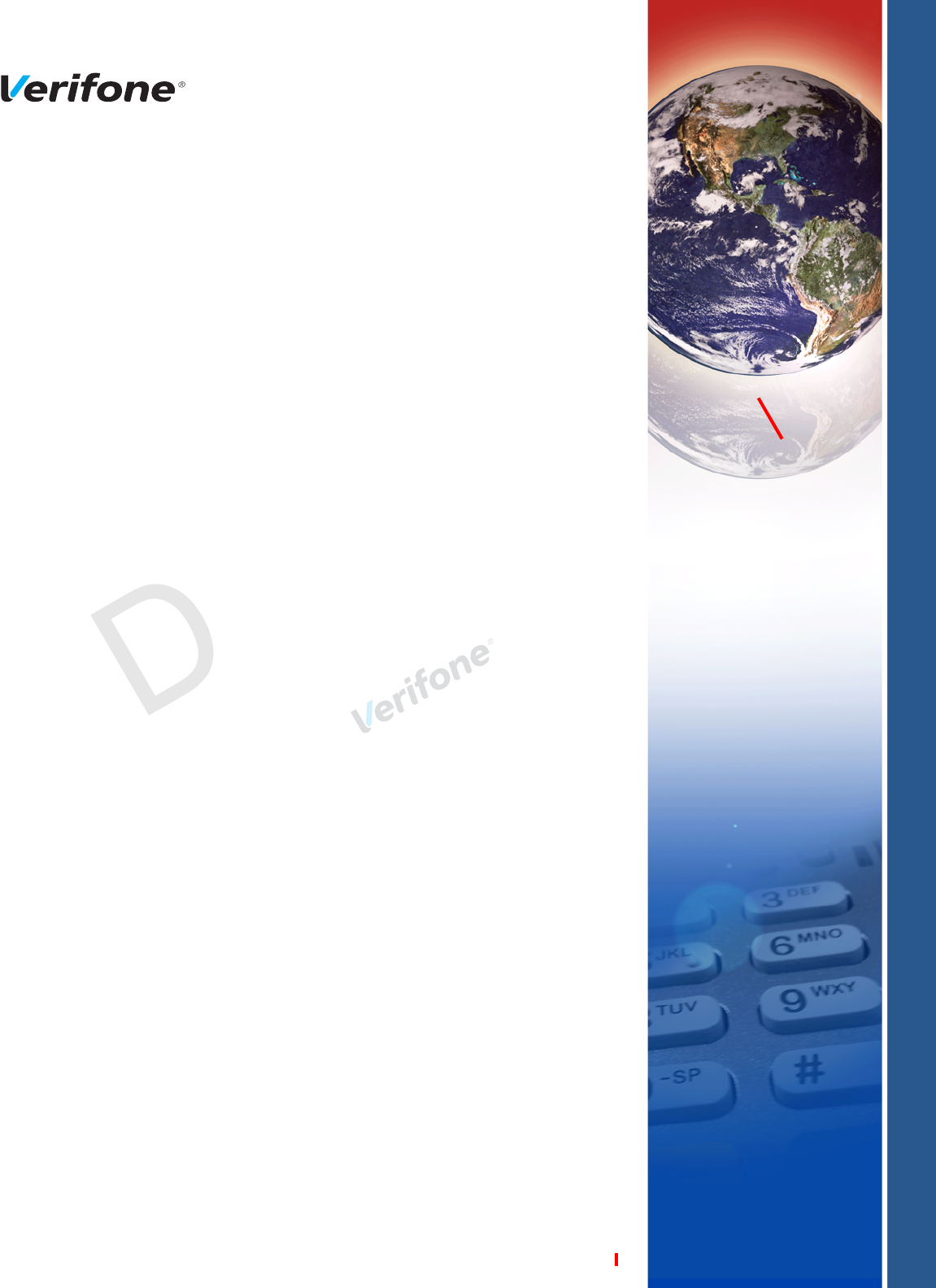Verifone C6803GBTW Point of Sales Terminal User Manual
VeriFone Inc Point of Sales Terminal
Verifone >
User manual
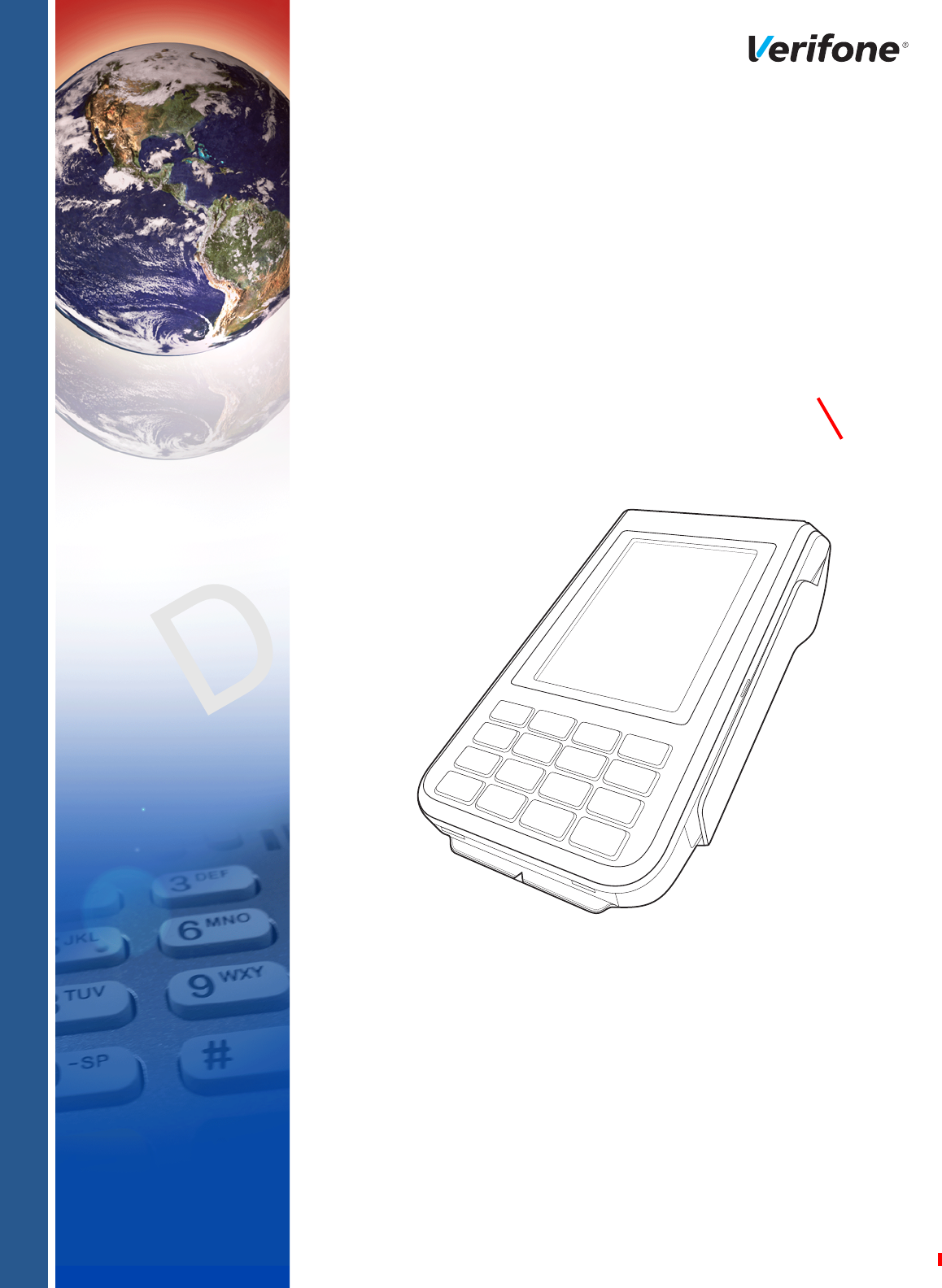
Verifone Part Number DOC268-063-EN-B, Revision B.6
RAFT
R
EVISION
B.6
C680
Installation Guide

All rights reserved. No part of the contents of this document may be reproduced or transmitted in any form without the written
permission of Verifone, Inc.
The information contained in this document is subject to change without notice. Although Verifone has attempted to ensure the
accuracy of the contents of this document, this document may include errors or omissions. The examples and sample programs are
for illustration only and may not be suited for your purpose. You should verify the applicability of any example or sample program
before placing the software into productive use. This document, including without limitation the examples and software programs, is
supplied “As-Is.”
Verifone, Inc.
1-800-Verifone
www.verifone.com
Verifone Part Number DOC268-063-EN-B, Revision B.6
C680 Installation Guide
© 2016 Verifone, Inc.
RAFT
R
EVISION
B.6
Verifone, the Verifone logo, VeriCentre, and Verix are registered trademarks of Verifone. Other brand names or trademarks
associated with Verifone’s products and services are trademarks of Verifone, Inc.
All other brand names and trademarks appearing in this manual are the property of their respective holders.
Comments? Please e-mail all comments on this document to your local Verifone Support Team.
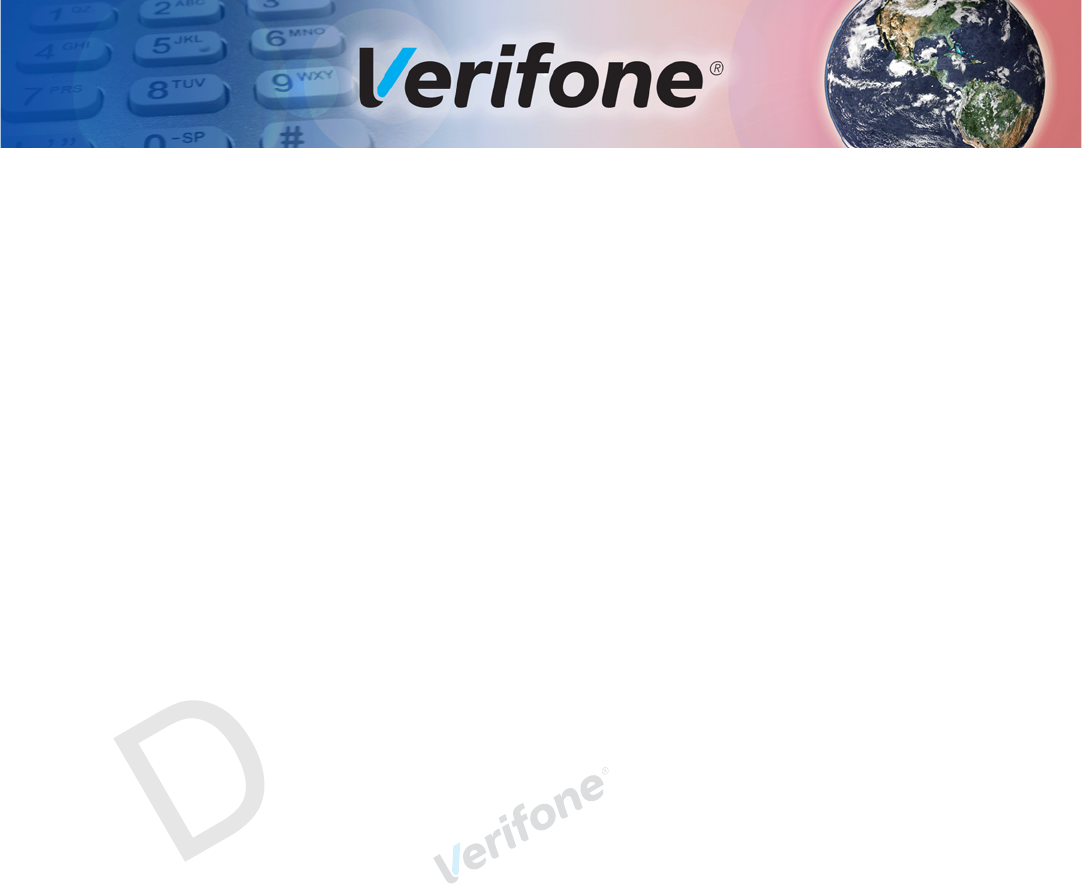
C680 I
NSTALLATION
G
UIDE
3
RAFT
R
EVISION
B.6
C
ONTENTS
P
REFACE
. . . . . . . . . . . . . . . . . . . . . . . . . . . . . . . . . . . . . . . 5
Audience. . . . . . . . . . . . . . . . . . . . . . . . . . . . . . . . . . . . . . . . . . . . . . . . . . . . . . . . 5
Organization . . . . . . . . . . . . . . . . . . . . . . . . . . . . . . . . . . . . . . . . . . . . . . . . . . . . . 5
Related Documentation . . . . . . . . . . . . . . . . . . . . . . . . . . . . . . . . . . . . . . . . . . . . 5
Conventions and Acronyms . . . . . . . . . . . . . . . . . . . . . . . . . . . . . . . . . . . . . . . . . 6
Document Conventions. . . . . . . . . . . . . . . . . . . . . . . . . . . . . . . . . . . . . . . . . . 6
Acronym Definitions . . . . . . . . . . . . . . . . . . . . . . . . . . . . . . . . . . . . . . . . . . . . 7
C
HAPTER
1
Terminal Overview
Features and Benefits . . . . . . . . . . . . . . . . . . . . . . . . . . . . . . . . . . . . . . . . . . . . 10
Exceptional Ease of Use. . . . . . . . . . . . . . . . . . . . . . . . . . . . . . . . . . . . . . . . 10
Performance and Durability . . . . . . . . . . . . . . . . . . . . . . . . . . . . . . . . . . . . . 10
Security. . . . . . . . . . . . . . . . . . . . . . . . . . . . . . . . . . . . . . . . . . . . . . . . . . . . . 10
Communication Technology . . . . . . . . . . . . . . . . . . . . . . . . . . . . . . . . . . . . . 10
C
HAPTER
2
Setup
Terminal Location. . . . . . . . . . . . . . . . . . . . . . . . . . . . . . . . . . . . . . . . . . . . . . . . 11
Ease of Use . . . . . . . . . . . . . . . . . . . . . . . . . . . . . . . . . . . . . . . . . . . . . . . . . 11
Environmental Factors . . . . . . . . . . . . . . . . . . . . . . . . . . . . . . . . . . . . . . . . . 11
Electrical Considerations . . . . . . . . . . . . . . . . . . . . . . . . . . . . . . . . . . . . . . . 12
Contactless Considerations . . . . . . . . . . . . . . . . . . . . . . . . . . . . . . . . . . . . . 12
PIN Protection Measures . . . . . . . . . . . . . . . . . . . . . . . . . . . . . . . . . . . . . . . 12
Inside the Shipping Carton . . . . . . . . . . . . . . . . . . . . . . . . . . . . . . . . . . . . . . . . . 12
Terminal Features . . . . . . . . . . . . . . . . . . . . . . . . . . . . . . . . . . . . . . . . . . . . . . . 14
3G Support . . . . . . . . . . . . . . . . . . . . . . . . . . . . . . . . . . . . . . . . . . . . . . . . . . 15
CDMA Support . . . . . . . . . . . . . . . . . . . . . . . . . . . . . . . . . . . . . . . . . . . . . . . 15
Wi-Fi/BT Support . . . . . . . . . . . . . . . . . . . . . . . . . . . . . . . . . . . . . . . . . . . . . 15
Installing the SIM/SAM/R-UIM/Micro-SD Cards . . . . . . . . . . . . . . . . . . . . . . . . . 15
Connection Ports . . . . . . . . . . . . . . . . . . . . . . . . . . . . . . . . . . . . . . . . . . . . . . . . 17
Cabling Connections. . . . . . . . . . . . . . . . . . . . . . . . . . . . . . . . . . . . . . . . . . . 17
Dedicated Micro-USB Device Port Connection. . . . . . . . . . . . . . . . . . . . . . . 17
Micro-USB Host Port Connection . . . . . . . . . . . . . . . . . . . . . . . . . . . . . . . . . 17
Powered RS-232/4-Pin Connection . . . . . . . . . . . . . . . . . . . . . . . . . . . . . . . 18
Powered RS-232/RJ11 Connection . . . . . . . . . . . . . . . . . . . . . . . . . . . . . . . 18
Installing the Paper Roll . . . . . . . . . . . . . . . . . . . . . . . . . . . . . . . . . . . . . . . . . . . 18
Installing the Dongle. . . . . . . . . . . . . . . . . . . . . . . . . . . . . . . . . . . . . . . . . . . . . . 19
Power Supply . . . . . . . . . . . . . . . . . . . . . . . . . . . . . . . . . . . . . . . . . . . . . . . . . . . 20
Using the Battery . . . . . . . . . . . . . . . . . . . . . . . . . . . . . . . . . . . . . . . . . . . . . . . . 21
Battery Features . . . . . . . . . . . . . . . . . . . . . . . . . . . . . . . . . . . . . . . . . . . . . . 21
Battery Behavior (No Power Pack). . . . . . . . . . . . . . . . . . . . . . . . . . . . . . . . . . . 22
Manual Startup . . . . . . . . . . . . . . . . . . . . . . . . . . . . . . . . . . . . . . . . . . . . . . . 22
Manual Shutdown . . . . . . . . . . . . . . . . . . . . . . . . . . . . . . . . . . . . . . . . . . . . . 22
Charging the Battery. . . . . . . . . . . . . . . . . . . . . . . . . . . . . . . . . . . . . . . . . . . . . . 22
Battery Life . . . . . . . . . . . . . . . . . . . . . . . . . . . . . . . . . . . . . . . . . . . . . . . . . . 22
Conducting Smart Card Transactions . . . . . . . . . . . . . . . . . . . . . . . . . . . . . . . . 23
Using the Magnetic Card Reader . . . . . . . . . . . . . . . . . . . . . . . . . . . . . . . . . . . . 23

C
ONTENTS
4
C680 I
NSTALLATION
G
UIDE
RAFT
R
EVISION
B.6
Conducting a Contactless Transaction. . . . . . . . . . . . . . . . . . . . . . . . . . . . . . . . 24
Wireless Transactions . . . . . . . . . . . . . . . . . . . . . . . . . . . . . . . . . . . . . . . . . . . . 24
Bluetooth Transactions. . . . . . . . . . . . . . . . . . . . . . . . . . . . . . . . . . . . . . . . . . . . 24
3G and CDMA Connectivity . . . . . . . . . . . . . . . . . . . . . . . . . . . . . . . . . . . . . . . . 24
Dial-up/Ethernet Connectivity. . . . . . . . . . . . . . . . . . . . . . . . . . . . . . . . . . . . . . . 24
Periodic Inspection . . . . . . . . . . . . . . . . . . . . . . . . . . . . . . . . . . . . . . . . . . . . . . . 25
C
HAPTER
3
Specifications and
Maintenance
Power Pack . . . . . . . . . . . . . . . . . . . . . . . . . . . . . . . . . . . . . . . . . . . . . . . . . . . . 27
Temperature. . . . . . . . . . . . . . . . . . . . . . . . . . . . . . . . . . . . . . . . . . . . . . . . . . . . 27
External Dimensions. . . . . . . . . . . . . . . . . . . . . . . . . . . . . . . . . . . . . . . . . . . . . . 27
Maintenance . . . . . . . . . . . . . . . . . . . . . . . . . . . . . . . . . . . . . . . . . . . . . . . . . . . . 27
Cleaning the Terminal. . . . . . . . . . . . . . . . . . . . . . . . . . . . . . . . . . . . . . . . . . 27
Terminal Contacts. . . . . . . . . . . . . . . . . . . . . . . . . . . . . . . . . . . . . . . . . . . . . 28
Smart Card Reader. . . . . . . . . . . . . . . . . . . . . . . . . . . . . . . . . . . . . . . . . . . . 28
C
HAPTER
4
Verifone Service
and Support
Returning a Terminal for Service . . . . . . . . . . . . . . . . . . . . . . . . . . . . . . . . . . . . 29
Accessories and Documentation . . . . . . . . . . . . . . . . . . . . . . . . . . . . . . . . . . . . 30
Dongle. . . . . . . . . . . . . . . . . . . . . . . . . . . . . . . . . . . . . . . . . . . . . . . . . . . . . . 30
Power Pack. . . . . . . . . . . . . . . . . . . . . . . . . . . . . . . . . . . . . . . . . . . . . . . . . . 30
Printer Paper. . . . . . . . . . . . . . . . . . . . . . . . . . . . . . . . . . . . . . . . . . . . . . . . . 30
Verifone Cleaning Kit . . . . . . . . . . . . . . . . . . . . . . . . . . . . . . . . . . . . . . . . . . 30
Micro-USB Cable . . . . . . . . . . . . . . . . . . . . . . . . . . . . . . . . . . . . . . . . . . . . . 31
Documentation . . . . . . . . . . . . . . . . . . . . . . . . . . . . . . . . . . . . . . . . . . . . . . . 31
C
HAPTER
5
Troubleshooting
Guidelines
Terminal Does Not Start . . . . . . . . . . . . . . . . . . . . . . . . . . . . . . . . . . . . . . . . . . . 33
Does Not Show Correct/Readable Info . . . . . . . . . . . . . . . . . . . . . . . . . . . . . . . 33
Battery Does Not Charge . . . . . . . . . . . . . . . . . . . . . . . . . . . . . . . . . . . . . . . . . . 34
Blank Display . . . . . . . . . . . . . . . . . . . . . . . . . . . . . . . . . . . . . . . . . . . . . . . . . . . 34
Printer Does Not Print. . . . . . . . . . . . . . . . . . . . . . . . . . . . . . . . . . . . . . . . . . . . . 34
Printer Paper Jam. . . . . . . . . . . . . . . . . . . . . . . . . . . . . . . . . . . . . . . . . . . . . . . . 35
Keypad Does Not Respond . . . . . . . . . . . . . . . . . . . . . . . . . . . . . . . . . . . . . . . . 35
Transactions Fail to Process . . . . . . . . . . . . . . . . . . . . . . . . . . . . . . . . . . . . . . . 35

C680 I
NSTALLATION
G
UIDE
5
RAFT
R
EVISION
B.6
P
REFACE
This guide is your primary source of information for setting up and installing the
C680 terminal.
Audience
This guide is useful for anyone installing and configuring a C680 terminal. Basic
descriptions of the terminal features are also provided.
Organization
This guide is organized as follows:
Chapter 1, Terminal Overview. Provides an overview of the terminal.
Chapter 2, Setup. Explains how to set up and install the terminal. Provides
information on how to select a location, establish power, and how to configure
optional peripheral devices.
Chapter 3, Specifications and Maintenance. Discusses power requirements,
dimensions, and how to maintain the terminal.
Chapter 4, Verifone Service and Support. Provides information on contacting your
local Verifone representative or service provider, and information on how to order
accessories or documentation from Verifone.
Chapter 5, Troubleshooting Guidelines. Provides troubleshooting guidelines,
should you encounter a problem in terminal installation and configuration.
Related
Documentation
To learn more about the C680 terminal, refer to the following set of documents:
C680
Certifications and Regulations Sheet DOC268-061-EN
C680
Quick Installation Guide DOC268-062-EN
C680
Reference Guide DOC268-064-EN
C680 3G Certifications and Regulations Sheet DOC268-065-EN
C680 WiFi-BT Certifications and Regulations Sheet DOC268-067-EN
C680 WiFi-BT Quick Installation Guide DOC268-068-EN
C680 CDMA Certifications and Regulations Sheet DOC268-069-EN
C680 FF Dongle
Certifications and Regulations Sheet DOC268-070-EN
C680 FF Dongle
Quick Installation Guide DOC268-071-EN
C680 TriComm
Certifications and Regulations Sheet DOC268-XXX-XX
C680 TriComm
Quick Installation Guide DOC268-XXX-XX
Verix eVo Volume I: Operating System Programmers Manual DOC00301
Verix eVo Volume II: Operating System and Communications
Programmers Manual
DOC00302
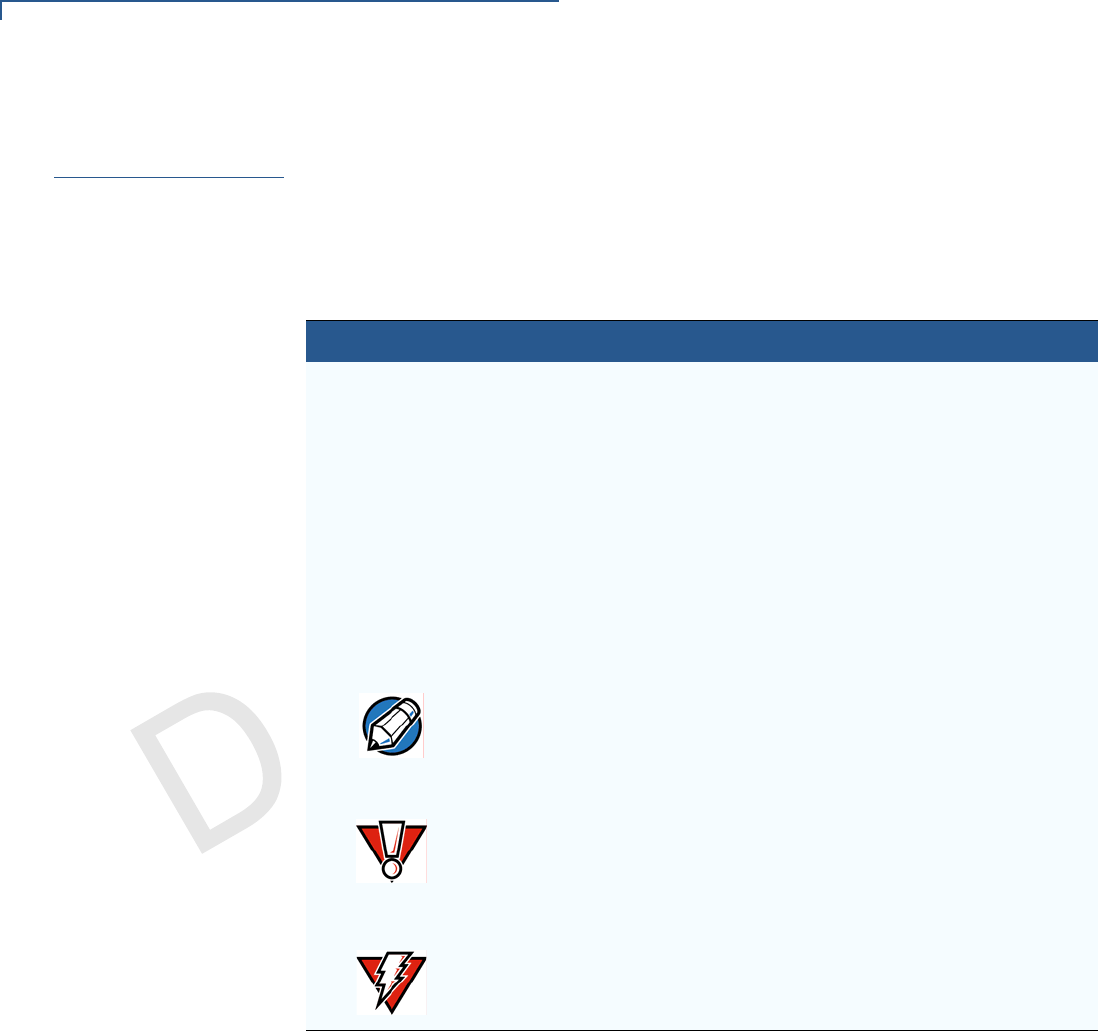
P
REFACE
Conventions and Acronyms
6
C680 I
NSTALLATION
G
UIDE
RAFT
R
EVISION
B.6
Conventions and
Acronyms
This section describes the conventions and acronyms used in this guide.
Document
Conventions
Various conventions are used to help you quickly identify special formatting. Table
1 describes these conventions and provides examples of their use.
Table 1 Document Conventions
Convention Meaning Example
Blue Text in blue indicates terms
that are cross referenced.
See Conventions and Acronyms.
Italics Italic typeface indicates
book titles or emphasis.
You must install a roll of thermal-
sensitive paper in the printer.
Courier The courier type face is
used while specifying
onscreen text, such as text
that you would enter at a
command prompt, or to
provide an URL.
http://www.verifone.com
The pencil icon is used to
highlight important
information.
RS-232-type devices do not work
with the PINpad port.
The caution symbol
indicates possible hardware
or software failure, or loss
of data.
The terminal is not waterproof or
dustproof, and is intended for indoor
use only.
The lightning symbol is
used as a warning when
bodily injury might occur.
Due to risk of shock do not use the
terminal near water.
NOTE
CAUTION
WARNING

P
REFACE
Conventions and Acronyms
C680 I
NSTALLATION
G
UIDE
7
RAFT
R
EVISION
B.6
Acronym Definitions
Various acronyms are used in place of the full definition. Table 2 presents
acronyms and their definitions.
Table 2 Acronym Definitions
Acronym Definitions
AC Alternating Current
CDMA Code Division Multiple Access
EMV Joint Europay, MasterCard and Visa Standard
GPRS General Packet Radio Service
GSM Global System for Mobile Communication
HDMI High-Definition Multimedia Interface
ITP Internal Thermal Printer
LCD Liquid Crystal Display
LED Light Emitting Diode
MRA Merchandise Return Authorization
MSAM Micromodule-Size Security Access Module
PED PIN Entry Device
PIN Personal Identification Number
POS Point-of-Sale
QVGA Quarter Video Graphics Array
RJ11 Registered Jack 11
RS-232 Recommended Standard 232
R-UIM Removable User Identity Module
SAM Security Access Module
SD Secure Digital
SIM Subscriber Identity Module
TFT Thin Film Transistor
UART Universal Asynchronous Transmitter/Receiver
USB Universal Serial Bus
VPN Verifone Part Number

P
REFACE
Conventions and Acronyms
8
C680 I
NSTALLATION
G
UIDE
RAFT
R
EVISION
B.6
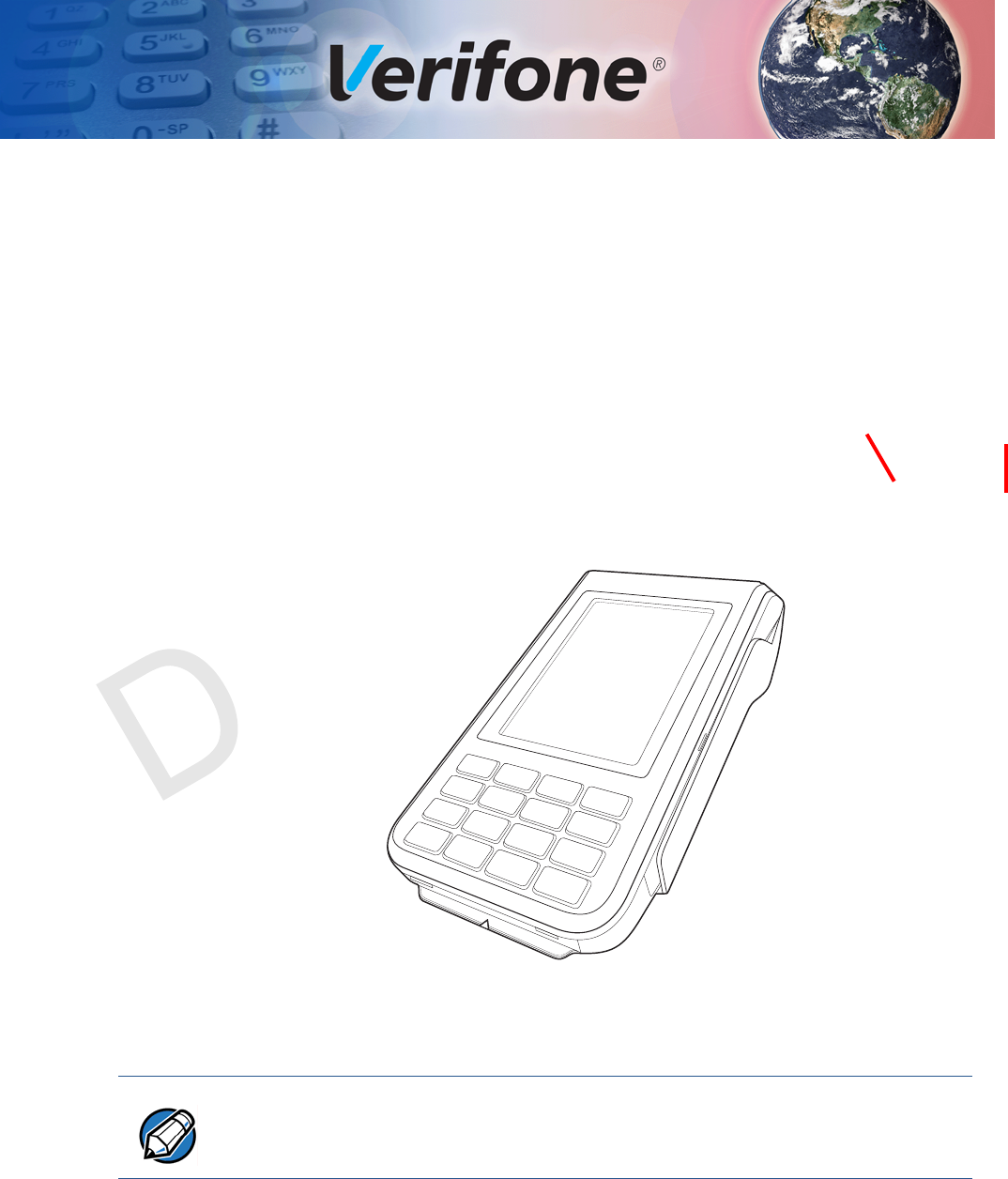
C680 I
NSTALLATION
G
UIDE
9
RAFT
R
EVISION
B.6
C
HAPTER
1
Terminal Overview
C680 features a color screen display, fast processor, abundant memory, and PCI
4.0 security.
It is a portable, battery-powered device designed to fit comfortably during
handheld consumer-facing applications. It features a 3.5” TFT LCD display and
spill-resistant keypad. It supports the GPRS, 3G, CDMA, Wi-Fi, and Bluetooth
communications technology.
Figure 1 C680 Terminal
NOTE
Verifone ships variants of this terminal for different markets. Your terminal may
have a different configuration.

T
ERMINAL
O
VERVIEW
Features and Benefits
10
C680 I
NSTALLATION
G
UIDE
RAFT
R
EVISION
B.6
Features and
Benefits
This terminal provides the right combination of features and functions including a
triple-track magnetic stripe card reader, smart card reader, color screen display,
and a quiet yet fast internal thermal printer (ITP).
Exceptional Ease of
Use
•
Lightweight, tapered design, compact, stylish and the ergonomic balance
allows convenient terminal hand-off to the consumer for PIN entry or other
input.
•
3.5” TFT LCD display for boundless application possibilities and easy
readability under various lighting conditions.
•
keypad provides tactile response to simplify usage and minimize finger slips.
•
40 mm diameter paper roll support with a trouble-free, drop-in, “clam shell”
loading and dual tear bar that allow receipts to be torn in any direction.
•
Quiet and fast integrated thermal printer.
•
Vertical magnetic stripe card reader with an extended blade for optimal card
reading.
Performance and
Durability
•
Fast transactions due to powerful 400 MHz ARM11 processor.
•
High-capacity 3.7 V, 2450 mAh Li-ion battery.
•
Base for drop-and-go charging.
•
Rounded corners and drop resistant to 3 feet on concrete floor to minimize
breakage.
•
192 MB of memory.
Security
•
PCI PED 4.0 approved for debit and other PIN-based transactions.
•
EMV Level 1 Type Approval.
•
Tamper-resistant construction, SSL protocols, and VeriShield file
authentication.
Communication
Technology
•
GPRS and 3G: Long-range wireless payment for retailers that do not have
physical location limitations.
•
CDMA: Long-rage wireless payment for Non-GPS coverage areas.
•
Wi-Fi: Ideal for retailers who need multiple wireless devices and have existing
IP infrastructure.
•
Bluetooth: Simple, plug-and-play installation for locations that need short-
range wireless capability.
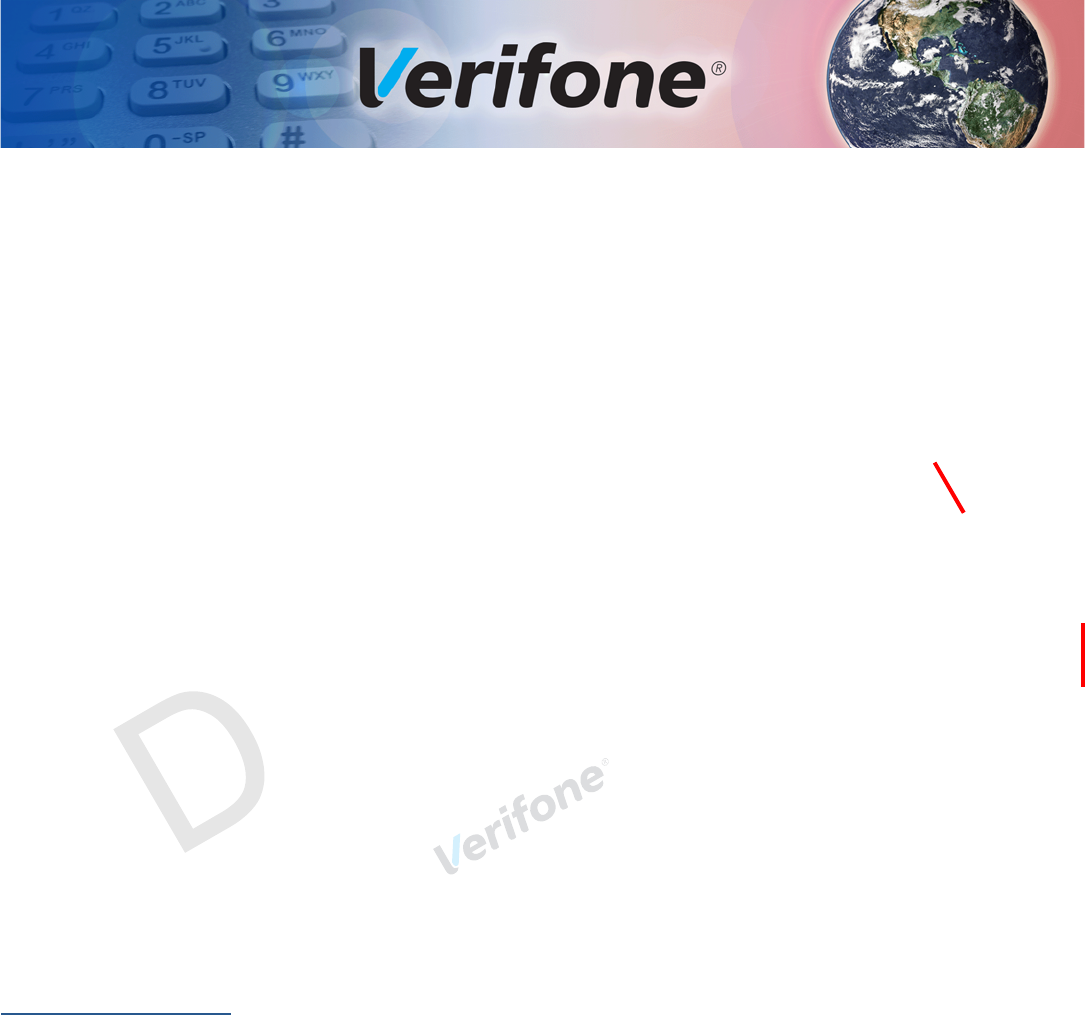
C680 I
NSTALLATION
G
UIDE
11
RAFT
R
EVISION
B.6
C
HAPTER
2
Setup
This chapter describes the terminal setup procedures for:
•
Terminal Location
•
Inside the Shipping Carton
•
Terminal Features
•
Installing the SIM/SAM/R-UIM/Micro-SD Cards
•
Connection Ports
•
Installing the Paper Roll
•
Installing the Dongle
•
Power Supply
•
Using the Battery
•
Battery Behavior (No Power Pack)
•
Charging the Battery
•
Conducting Smart Card Transactions
•
Using the Magnetic Card Reader
•
Conducting a Contactless Transaction
Terminal
Location
Use the following guidelines when selecting a location for the terminal.
Ease of Use
•
Select a location convenient for both merchant and cardholder.
•
Select a flat support surface, such as a countertop or table.
•
Select a location near a power outlet, ECR, or computer connected to the
terminal. Do not string cables or cords across a walkway for safety.
Environmental
Factors
•
Do not use where there is high heat, dust, humidity, moisture, or caustic
chemicals or oils.
•
Keep away from direct sunlight and anything that radiates heat, such as a
stove or motor.

S
ETUP
Terminal Location
12
C680 I
NSTALLATION
G
UIDE
RAFT
R
EVISION
B.6
•
Do not use outdoors.
Electrical
Considerations
•
Avoid using the unit during electrical storms.
•
Avoid locations near electrical appliances or other devices that cause
excessive voltage fluctuations or emit electrical noise (for example, air
conditioners, electric motors, neon signs, high-frequency or magnetic security
devices, or computer equipment).
•
Do not use near water or in moist conditions.
•
Disconnect the device from its POS terminal before cleaning.
Contactless
Considerations
Avoid having metallic objects in proximity of the contactless antenna. If you need
to mount the terminal to vertical or inclined surfaces, use a flat, non-metallic
mounting plate.
PIN Protection
Measures
The C680 is a handover device. Always exercise extreme caution when
conducting transactions, specially during PIN entry.
•
Hand the terminal directly to the cardholder for PIN entry.
•
Encourage the cardholder to hold the terminal close to avoid others from
seeing the information being entered.
Ensuring User Privacy
Use the following guidelines to protect the user’s privacy when he enters his
personal identification number (PIN):
•
The area of visibility should be no larger than a cone taken from the number 5
key at an angle of 45° and covering an area of 270° directly in front of the user.
CAUTION
This unit is not waterproof or dustproof and is intended for indoor use only. Any
damage to the terminal from exposure to rain or dust may void any warranty.
WARNING
Do not use near water, including a bathtub, wash bowl, kitchen sink or laundry
tub, in a wet basement, or near a swimming pool to avoid shock or damage.
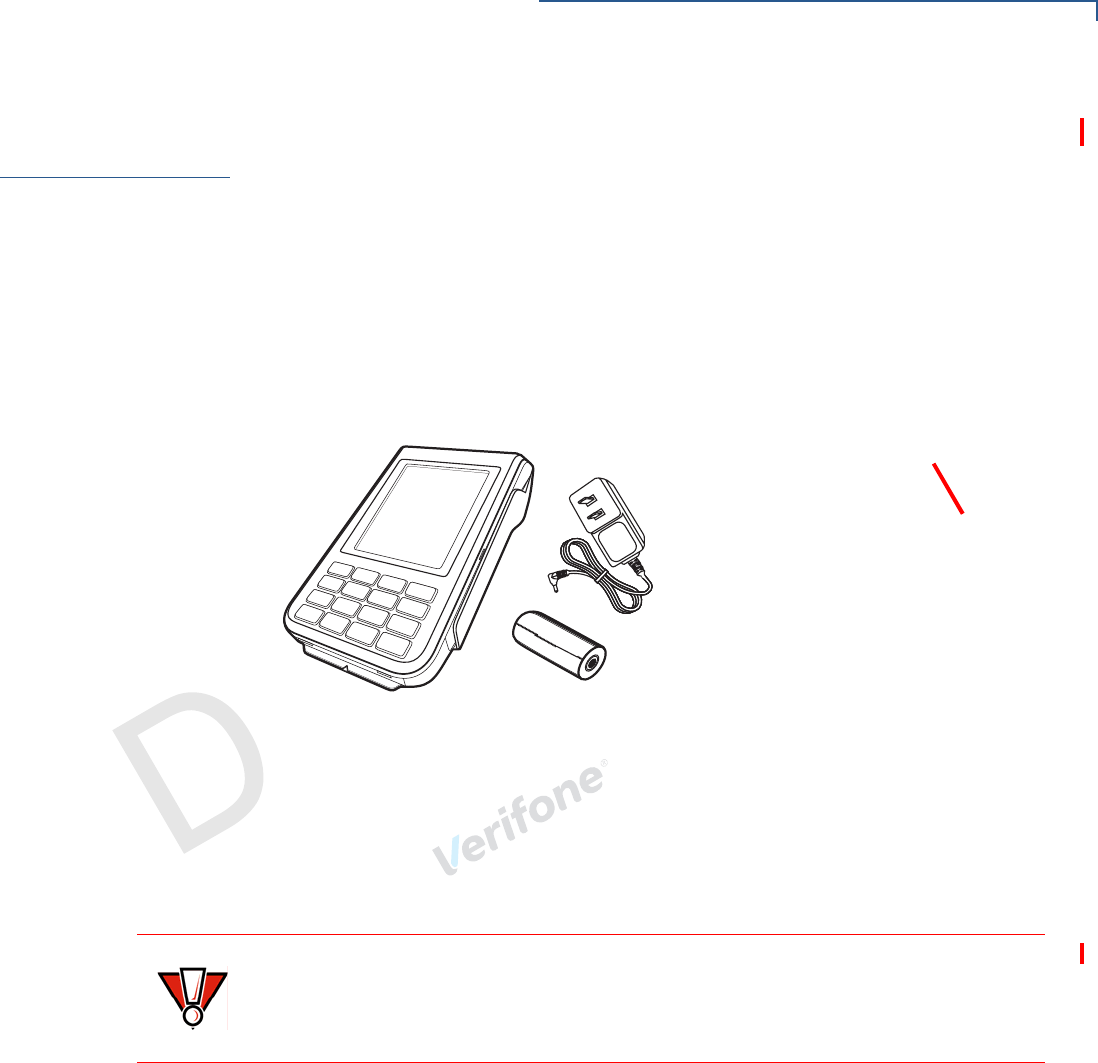
S
ETUP
Inside the Shipping Carton
C680 I
NSTALLATION
G
UIDE
13
RAFT
R
EVISION
B.6
Inside the
Shipping Carton
Open the shipping carton and carefully inspect its contents for possible tampering
or shipping damage. The terminal is a secure product. Tampering causes it to
cease to function or to operate in an unsecured manner.
Unpacking the
Shipping Carton To unpack the shipping carton:
1
Remove and inspect the following items:
•
Terminal
•
Power pack
•
Paper roll
Figure 2 Items Inside the Box
2
Remove all plastic wrapping from the terminal and other components.
3
Remove the clear protective film from the LCD screen.
4
Save the shipping carton and packing material for future repacking or moving
the terminal.
CAUTION
Do not use a unit that has been damaged or tampered with. The terminal comes
equipped with tamper-evident labels. If a label or component appears damaged,
please notify the shipping company and your Verifone representative or service
provider immediately.
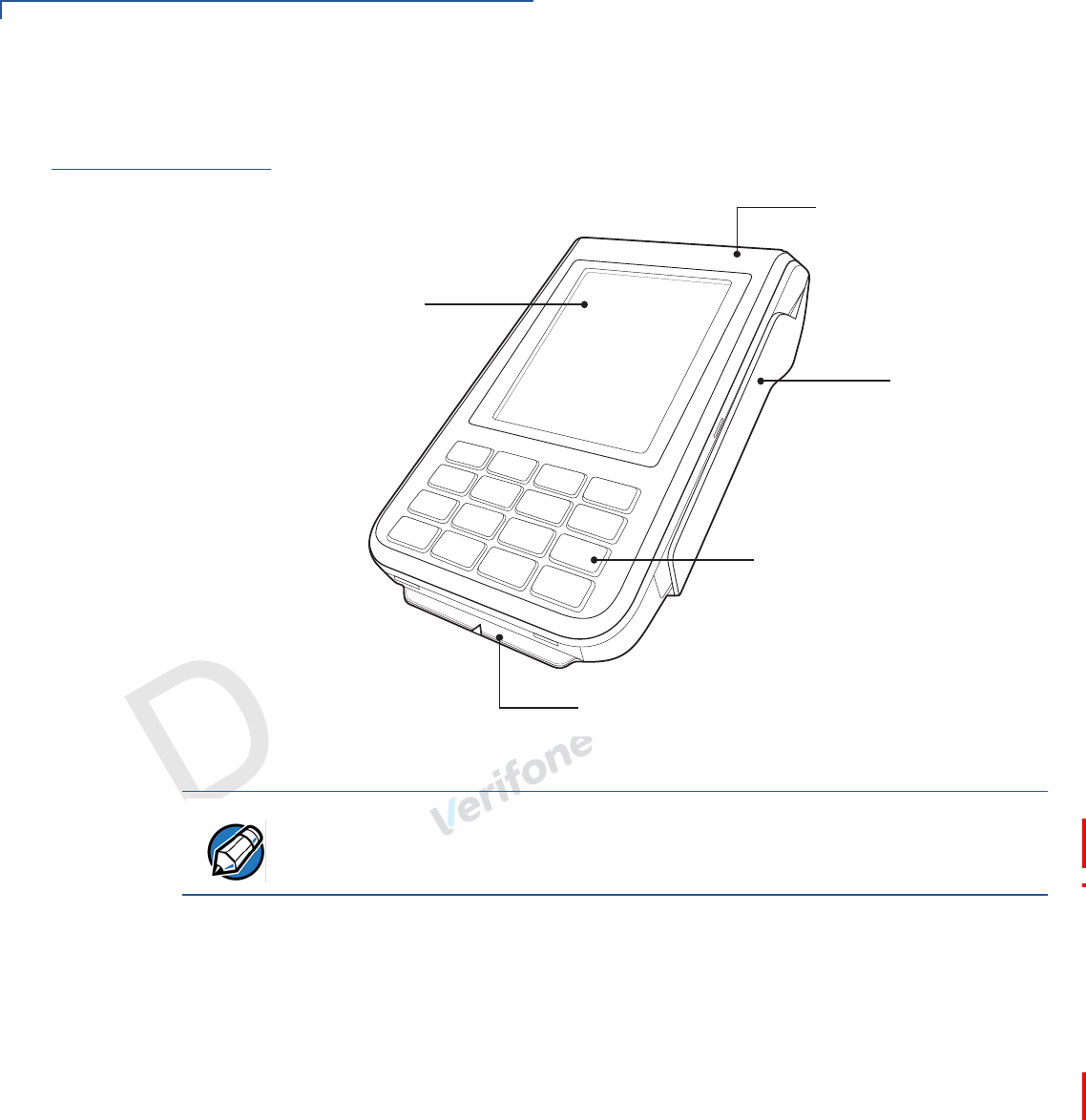
S
ETUP
Terminal Features
14
C680 I
NSTALLATION
G
UIDE
RAFT
R
EVISION
B.6
Terminal
Features
Familiarize yourself with the terminal features before continuing with the
installation process:
Figure 3 C680 Terminal Features
The unit offers the following features:
•
A 3.5” touch screen, TFT LCD display.
•
A set of keys that include:
a
A 12-key, telephone-style keypad (keypads may vary in style).
b
Four color-coded function keys from top to bottom ( POWER, CANCEL,
CLEAR, ENTER).
•
A magnetic card reader, built into the right side. An icon illustrates the proper
card direction, with the magnetic stripe down and facing inward, toward the
keypad.
•
An internal thermal printer at the top front of the terminal.
•
A smart card reader, built into the bottom of the terminal. An icon indicates the
proper card position and insertion point.
•
A SAM (Security Access Module) compartment, built into the bottom of the
terminal inside the back compartment.
TOUCHSCREEN
DISPLAY
MAGNETIC
CARD READER
SMARTCARD
READER
TELEPHPONE-STYLE
KEYPAD
THERMAL
PRINTER
NOTE
V
Verifone ships variants of C680 terminals to different markets. Your terminal may
have a different configuration from the features described in this section.
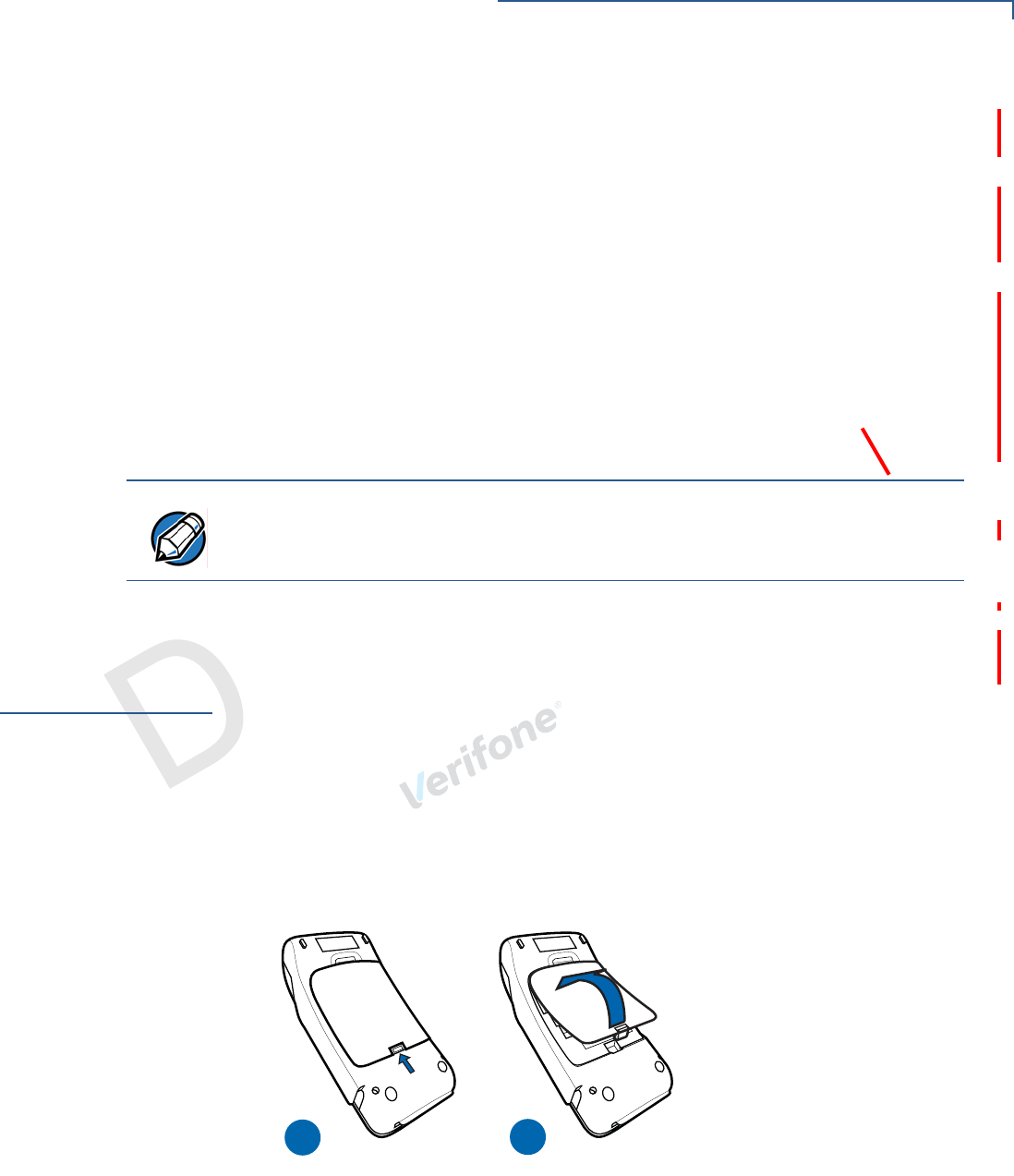
S
ETUP
Installing the SIM/SAM/R-UIM/Micro-SD Cards
C680 I
NSTALLATION
G
UIDE
15
RAFT
R
EVISION
B.6
3G Support
The 3G variant uses Gemalto EHS6 radio module that incorporates 3G High-
Speed Packet Access (HSPA) connectivity.
CDMA Support
The CDMA variant uses Telit CE910-SC module, a single-band 800 MHz CEMA
1XRTT wireless module designed for APAC networks requiring R-UIM card
technology.
Wi-Fi/BT Support
The Wi-Fi/BT integrated module variant uses Broadcomm BCM43340 single chip
solution, which provides SDIO interface for Wi-Fi and UART interface for
Bluetooth.
The module icludes an integrated WLAN RF transceiver optimized for use in
Wireless LAN systems with advanced power management unit and an integrated
radio transceiver optimized for use in the Bluetoth wireless systems.
Installing the
SIM/SAM/R-UIM/
Micro-SD Cards
You may need to install or replace a GSM SIM (Subscriber Identity Module) or R-
UIM (Removable User identity Module) card, one or two SAM (Security Access
Module) cards, or a micro-SD card.
To Install or Replace a
SIM Card
1
Ensure that the terminal is turned off.
2
Place the terminal upside down on a soft, clean surface to protect the lens
from scratches.
3
Gently push the compartment cover’s locking mechanish to release. Lift and
remove the cover.
Figure 4 Remove Terminal Back Cover
4
Lift the battery pack.
NOTE
C680 TriComm variant features Wi-Fi, BT, and 3G connectivity.
AB
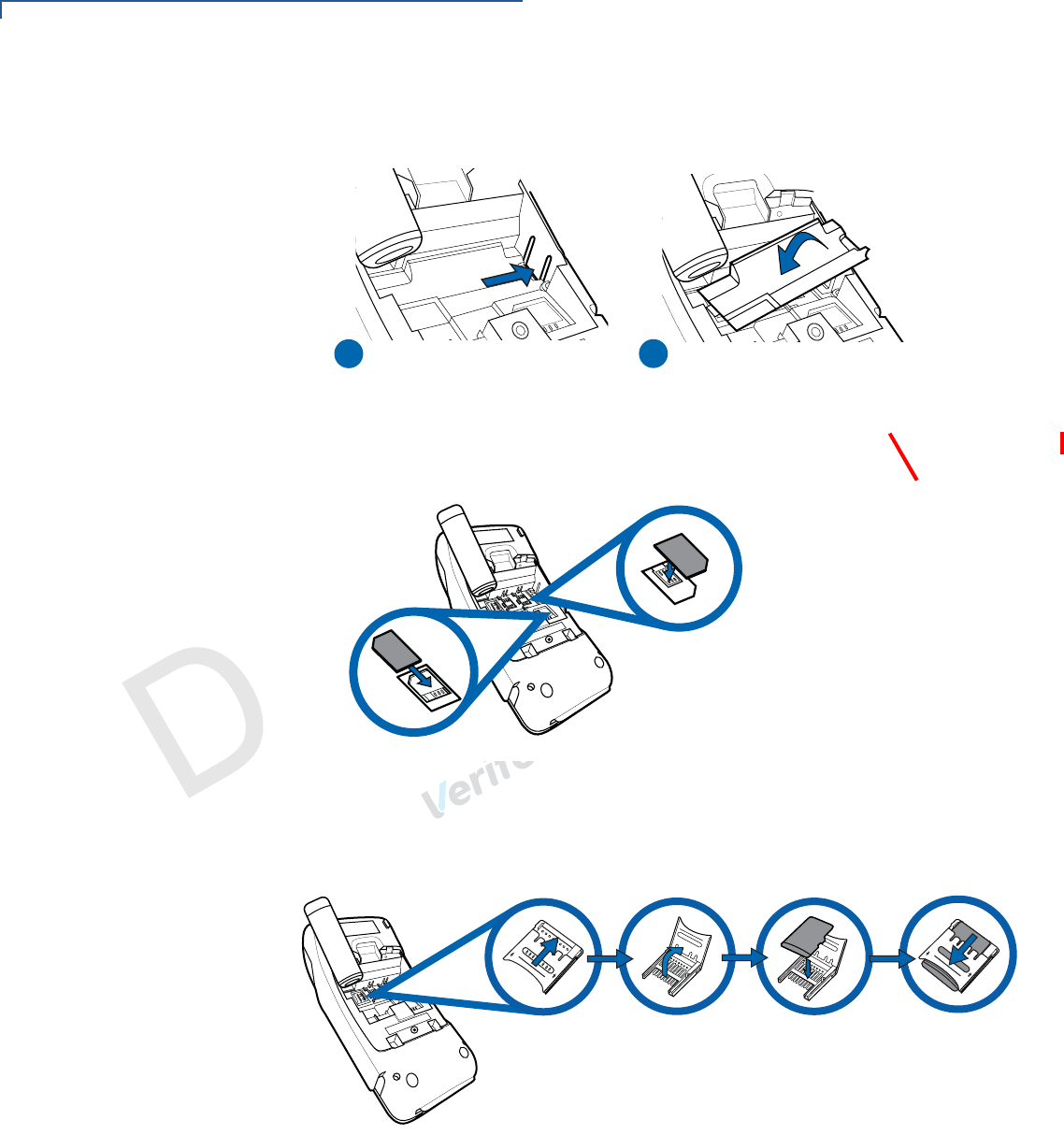
S
ETUP
Installing the SIM/SAM/R-UIM/Micro-SD Cards
16
C680 I
NSTALLATION
G
UIDE
RAFT
R
EVISION
B.6
5
Remove the card slot cover by pushing the movable side of of the terminal
with your finger or by using a screw driver to release.
Figure 5 Remove Card Slot Cover
6
With the gold contacts facing down, insert the SIM/SAM/R-UIM card into the
cardholder.
Figure 6 SIM/SAM Card Installation
For micro-SD card, slide down the card slot cover to open. Insert the SD card
facing down and slide back the slot cover to lock.
Figure 7 SD Card Installation
7
Return the card card slot cover.
8
Return the battery pack to its original position.
9
Close and screw the back compartment cover.
N
EPO
K
COL
AB
OPEN
LOCK
OPEN
LOCK
OPEN
LOCK
OPEN
LOCK
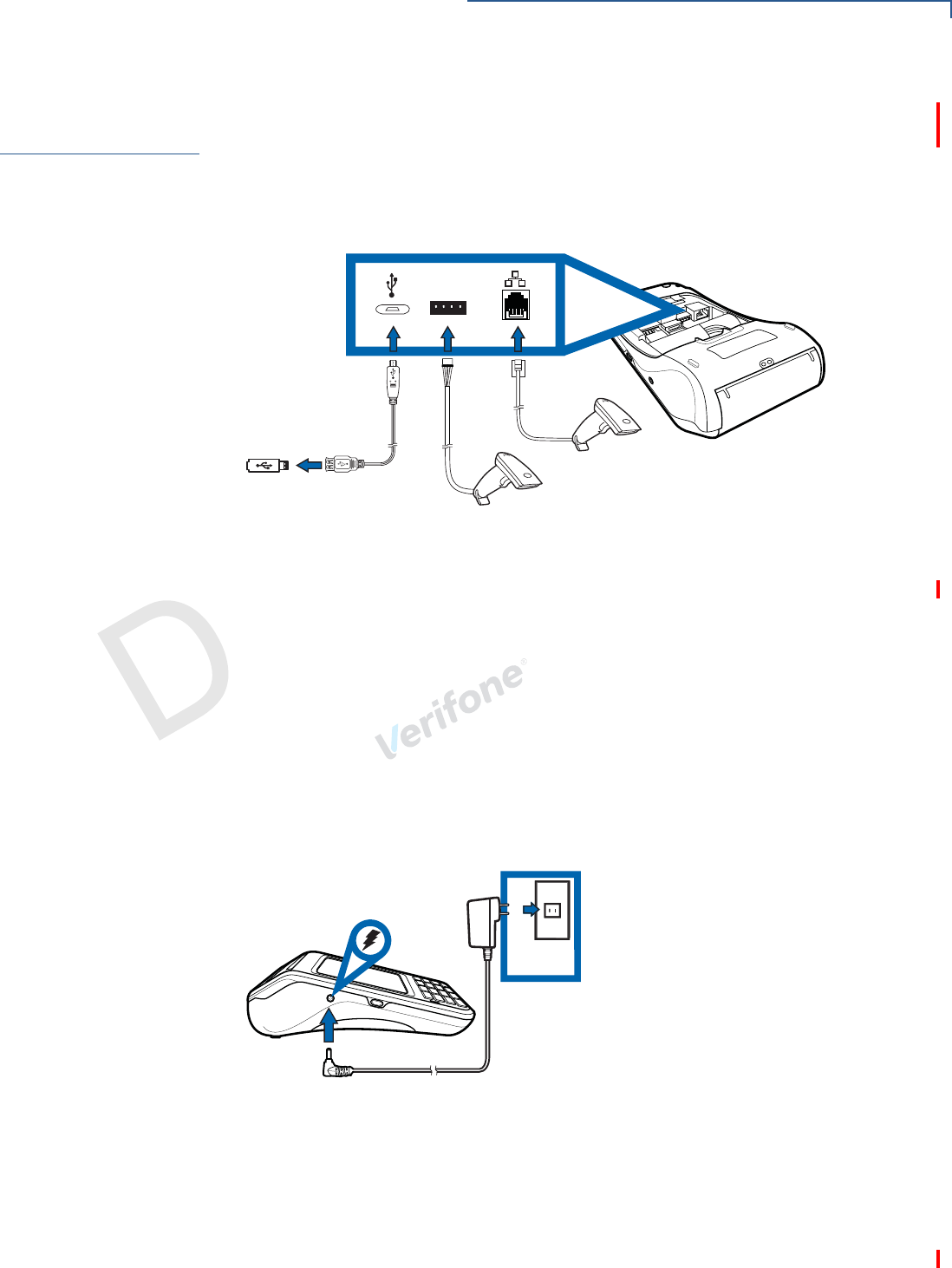
S
ETUP
Connection Ports
C680 I
NSTALLATION
G
UIDE
17
RAFT
R
EVISION
B.6
Connection
Ports
The terminal has one primary micro-USB port on the side used for power and/or
download.
There is another micro-USB connector USB Host located at the back of the
terminal for peripheral connection. Powered RS-232 is supported via RJ11 for
modem connection, and via a 4-pin connector debug and OS download.
Figure 8 Connection Ports
Cabling
Connections
The following are cabling scenarios for your unit:
1
Dedicated Micro-USB Device Port Connection
2
Micro-USB Host Port Connection.
3
Powered RS-232/4-Pin Connection.
4
Powered RS-232/RJ11 Connection
Dedicated Micro-
USB Device Port
Connection
The micro-USB Device port on the side of the unit is dedicated to download/power
charging. Insert the micro-USB plug end of the Host connector cable to the micro-
USB port on the terminal to connect.
Figure 9 Dedicated Micro USB Device Port
Micro-USB Host
Port Connection
The micro-USB Host port on the back of the unit is used for connecting peripheral
devices. Insert the micro-USB plug end of the pheriperal cord to the micro-USB
port on the back of the terminal to connect.
4 PIN WIRE
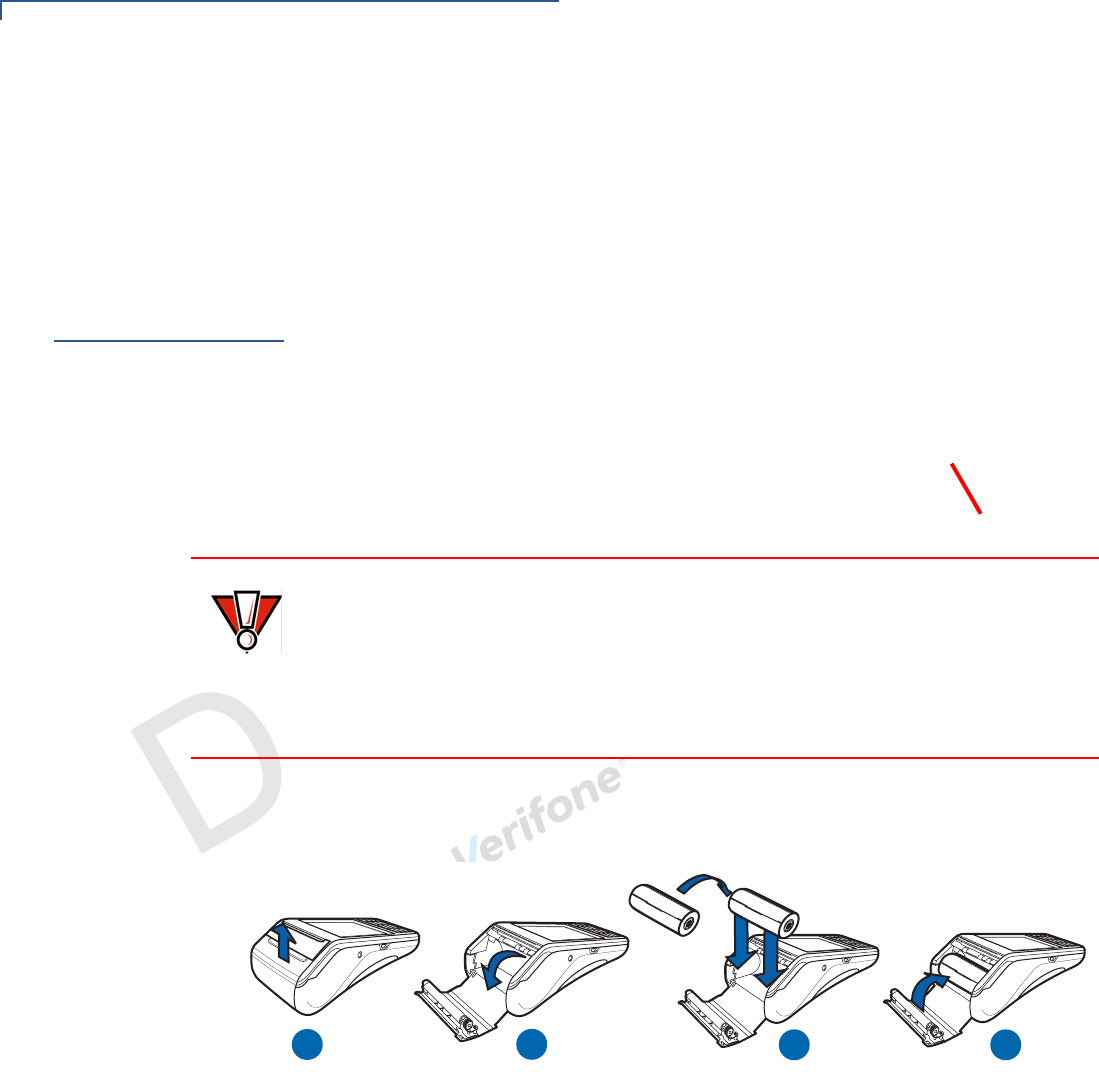
S
ETUP
Installing the Paper Roll
18
C680 I
NSTALLATION
G
UIDE
RAFT
R
EVISION
B.6
Powered RS-232/4-
Pin Connection
The powered RS-232/4-pin connector on the back of the terminal is mainly
designed for 1D/2D barcode scanner.
Powered RS-232/
RJ11 Connection
Similar to 4-pin connection, powered RS-232/RJ11 connector on the back of the
terminal is designed for 1D/2D barcode scanner.
Installing the
Paper Roll
A fast, quiet thermal printer is built into the terminal. Before you can process
transactions that require a receipt or record, you must install a roll of thermal-
sensitive paper in the printer.
The ITP uses a roll of 40 mm single-ply, thermal-sensitive paper. A pink out-of-
paper indicator line appears on the edge of the paper approximately 18 inches
before the end of the roll.
After this line appears, there is enough paper remaining on the roll to conclude at
least one transaction.
To Install a Paper Roll
1
Gently pull the latch located on top of the terminal to unlock the paper roll
cover.
Figure 10 Paper Roll Installation
2
Lift the printer cover up to open.
3
Remove any partial roll of paper in the printer tray.
4
Loosen the glued leading edge of the new roll of paper or remove the
protective strip, if applicable. Unwind the paper roll past any glue residue.
5
Hold the roll so the paper feeds from the bottom of the roll.
6
Drop the paper roll into the printer tray.
7
Pull paper up past the glue residue on the paper roll.
CAUTION
Poor-quality paper can jam the printer and create excessive paper dust. To order
high-quality Verifone paper, refer to Accessories and Documentation.
Store thermal paper in a dry, dark area and handle carefully. Impact, friction,
temperature, humidity, and oils affect the color and storage characteristics of the
paper. Never load a roll of paper with folds, wrinkles, tears, or holes at the edges
in the print area.
ABC D
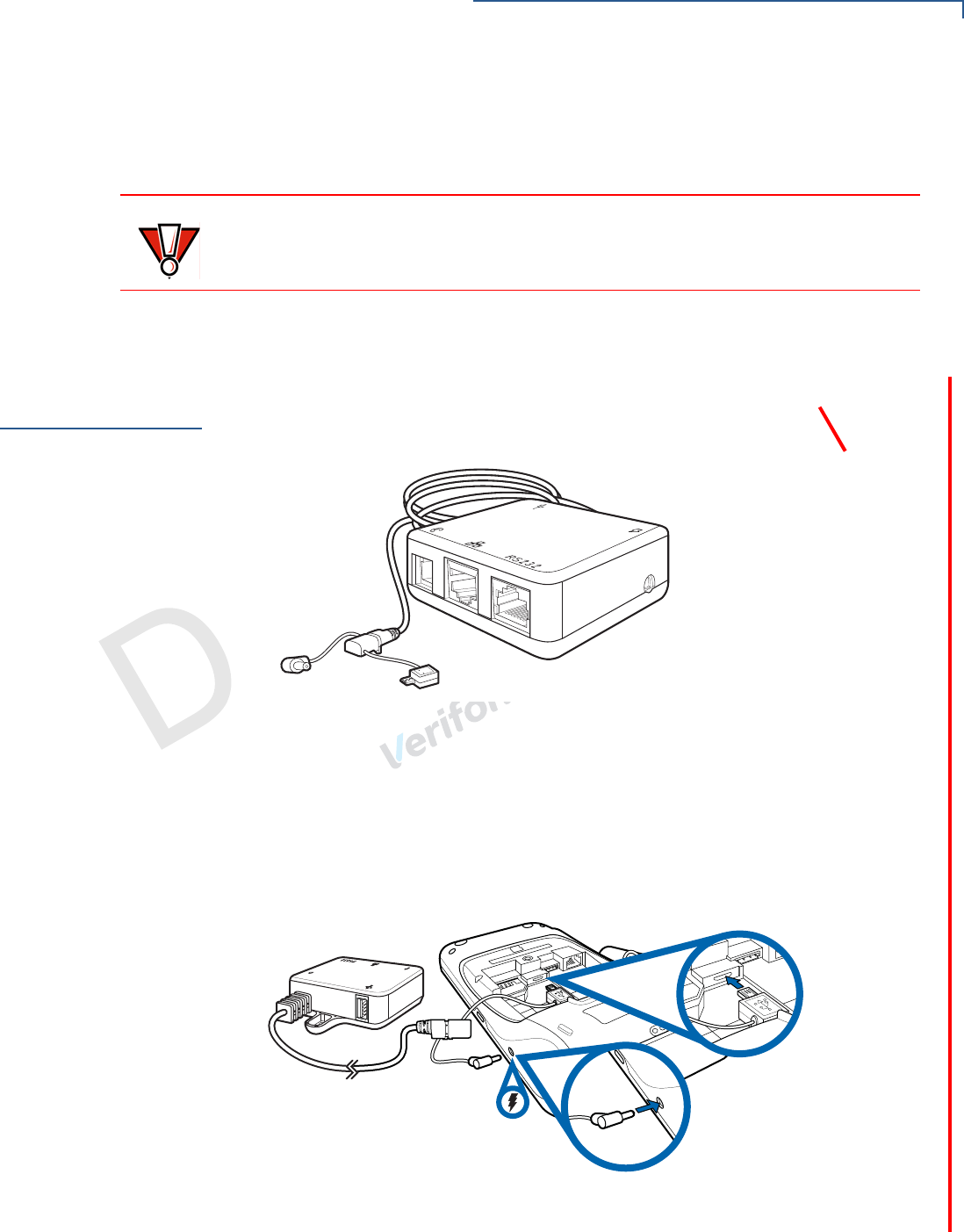
S
ETUP
Installing the Dongle
C680 I
NSTALLATION
G
UIDE
19
RAFT
R
EVISION
B.6
8
Close the paper roll cover by gently pressing directly on the cover until it clicks
shut, allowing a small amount of paper past the glue residue to extend outside
the printer door.
9
Tear the paper off against the serrated plastic strip in the printer.
Installing the
Dongle
C680 Dongle is supported in some countries. It provides dial-up/Ethernet
connectivity and offers USB and peripheral devices connection. It is shipped
together with a retrofitted terminal cover to accommodate the Dongle’s Y cable.
Figure 11 C680 Dongle
To install the Dongle:
1
Remove the terminal’s original back cover to access the ports.
2
Insert the Dongle’s micro-USB connector to the terminal’s micro-USB port and
connect the power barrel connector to the power port on the side of the
terminal.
Figure 12 Micro-USB and Power Connection
CAUTION
To prevent damaging the print roller, always gently press down on the paper roll
cover to close it.
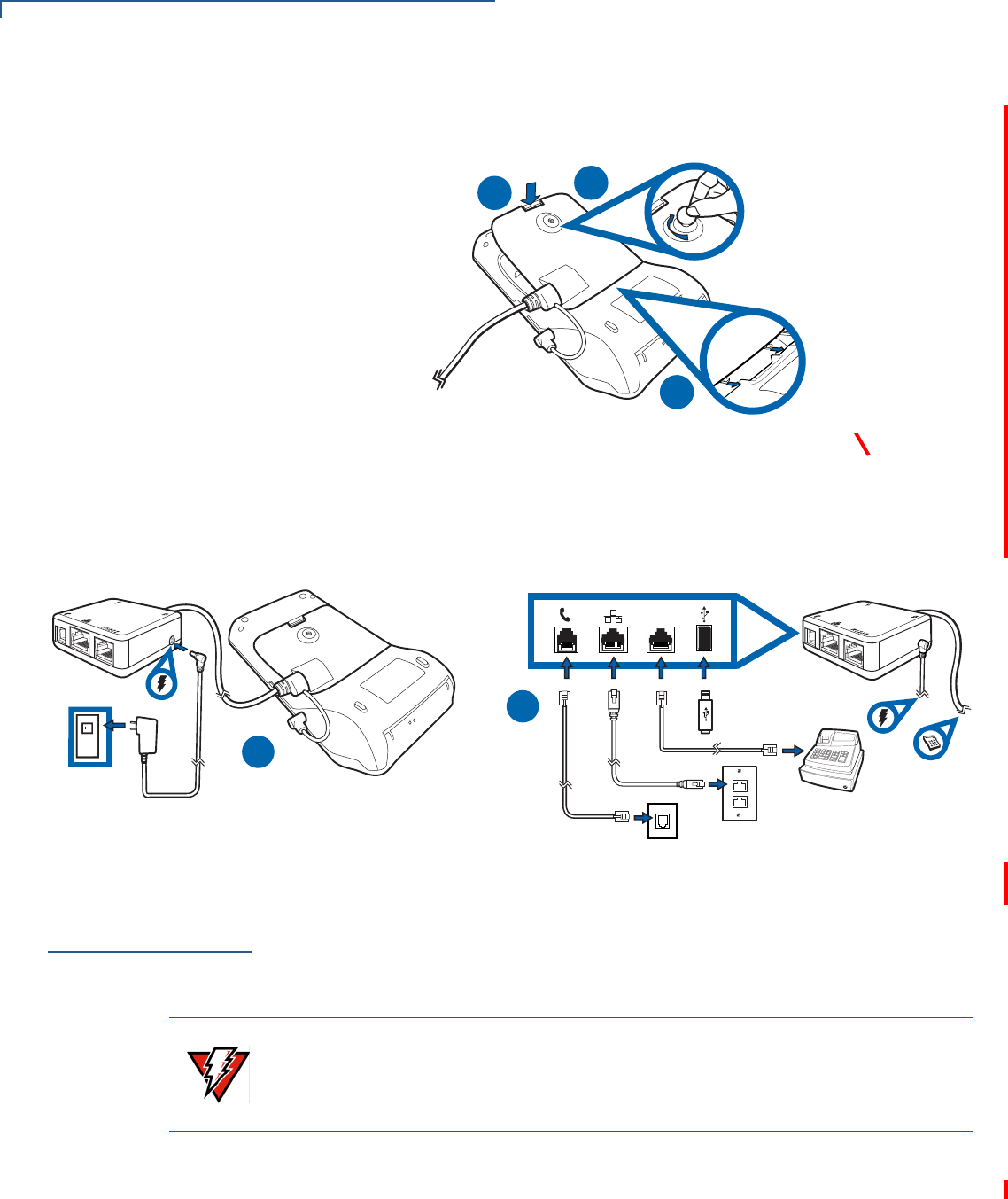
S
ETUP
Power Supply
20
C680 I
NSTALLATION
G
UIDE
RAFT
R
EVISION
B.6
3
Replace the original cover with the new retrofitted cover and slide it back in
place to unexpose the ports. Screw to secure.
Figure 13 Replacing Old Cover with Retrofitted Cover To Close
4
Plug the power pack to the power outlet to prepare the Dongle for the
necessary connections (dial-up, LAN, peripheral device, and USB). See
Power Supply for more information.
Figure 14 Plugging the Dongle to the Power Outlet and Supported
Connections to the Dongle
Power Supply
After establishing all necessary connections, connect the power pack to the
terminal and into a wall outlet or powered surge protector to charge the battery for
six hours or until fully charged.
Each C680 terminal comes with power supply (VPN PWRXXX-001-XX-A) used to
connect the terminal directly to a power outlet and to charge the battery.
B
A
A
C
RS-232
A
B
WARNING
Do not plug the power pack into an outdoor outlet or operate the terminal
outdoors. During a transaction, disconnecting the power by removing the battery
or unplugging the terminal from a wall power while at very low battery charge may
cause transaction data files not yet stored in the terminal memory to be lost.
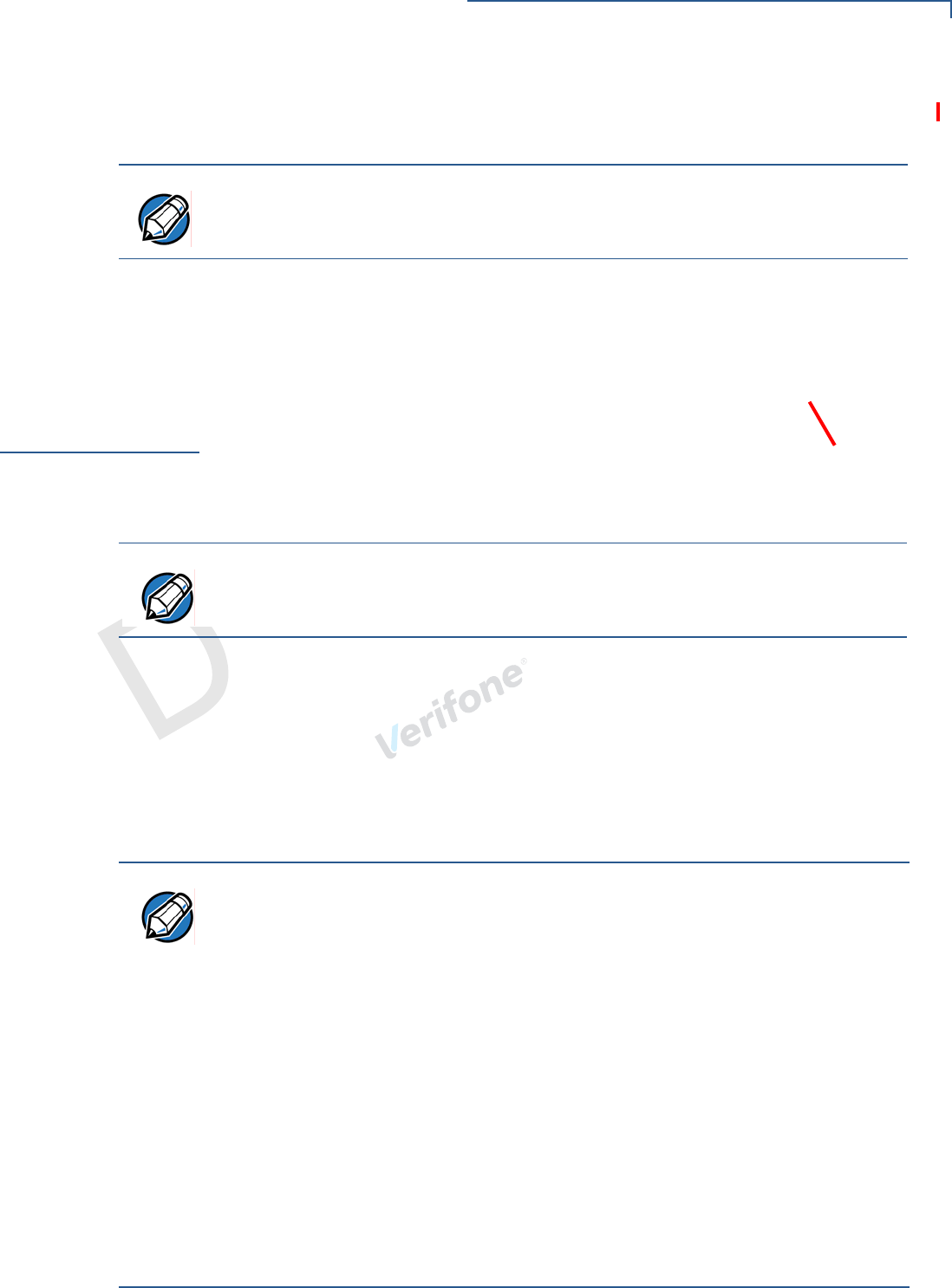
S
ETUP
Using the Battery
C680 I
NSTALLATION
G
UIDE
21
RAFT
R
EVISION
B.6
The C680 unit comes with a universal input power pack capable of operating from
voltages of 100 V to 240 V AC.
Once it loads the application, the terminal starts the initial Verifone copyright
screen and displays a unique copyright screen. If there is no available application
in the terminal, DOWNLOAD NEEDED appears on screen after the initial Verifone
copyright screen.
Using the
Battery
The C680 terminal uses a single cell Li-ion battery (see Accessories and
Documentation for ordering information). The internal logic of the battery prevents
both overcharging and undercharging (a fault condition in which the battery level
goes well below the minimum acceptable charge and the battery becomes
unusable).
Battery Features
The following are features of the battery:
•
Single cell Li-ion 2450 mAH battery pack.
•
A safety circuit that:
•
Prevents cell damage from overcharge, over-discharge, or overheating.
•
Activates when the battery is left in an unused terminal for extended
periods.
NOTE
To protect against possible damage caused by lightning strikes and electrical
surges, consider installing a power surge protector.
NOTE
The C680 terminal will only operate when the battery is installed.
NOTE
•
C680 battery pack (PN BPK260-001-01-A) not customer changeable and
therefore should not be disconnected and removed.
•
Li-ion batteries are not affected by shallow charging. Furthermore, when the
terminal has no external power source or battery, the coin cell battery
provides power to the security circuit.
•
Disconnecting and removing the battery, as well as unplugging the terminal
power pack, reduce the life of the coin cell battery, which does not recharge
and must be replaced if drained.
•
Conserve battery power by turning the C680 terminal off when not in use.
Keep the Li-ion battery inserted in the terminal and power up the terminal
periodically to check the battery charge. Do not let the battery charge fall
below 10% for extended periods of time as this may permanently diminish the
battery capacity. Recharge the battery by attaching the micro-USB end of the
power pack to the terminal and plugging the other end of the power pack into
a wall outlet.
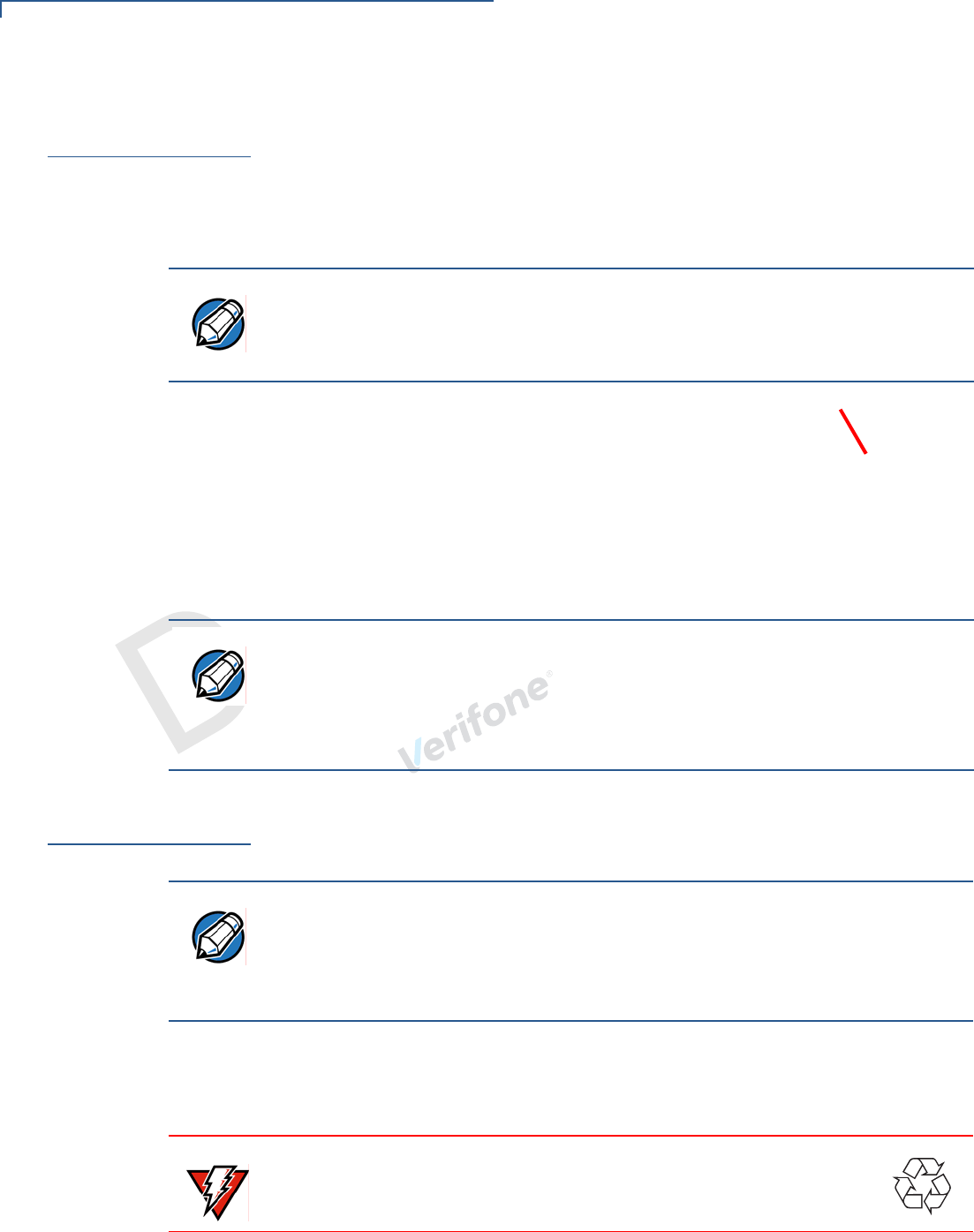
S
ETUP
Battery Behavior (No Power Pack)
22
C680 I
NSTALLATION
G
UIDE
RAFT
R
EVISION
B.6
Battery Behavior
(No Power Pack)
The terminal shifts to power pack mode and starts up automatically when the
C680 is connected to a non-battery power source, regardless of the battery
charge state.
Manual Startup
Hold the green key down for about 4 seconds until the terminal displays the
startup screen.
The Verifone copyright screen starts and displays a unique copyright screen once
the terminal loads an application. However, DOWNLOAD NEEDED appears on
screen after the initial Verifone copyright screen if there is no available application
in the terminal..
Manual Shutdown
Hold the red key down for about 4 seconds until the terminal displays the
shutdown verification screen. Keep holding the red key until the C680 terminal
shuts down.
Charging the
Battery
The battery has a safety circuit to protect the Li-ion cells from overcharging and
over-discharging. If the battery is over-discharged, the safety circuit shuts down
the battery. The battery must then be recharged to restore operation.
Battery Life
Charging and discharging the battery hundreds of times will wear out the battery.
Significantly reduced operating times indicate the need for battery replacement
(see Accessories and Documentation for ordering information).
NOTE
The 4-second power-up delay prevents terminal startup if the green key is
accidentally held down. The time required to hold the green key down to power up
the terminal is configurable. For more information, see C680 Reference Guide –
VPN
DOC269-004-EN
).
NOTE
•
The 4-second shutdown delay that prevents terminal shutdown if the red key
is accidentally held down. The time required to hold the red key down to shut
down the terminal is configurable (for more information, see the C680
Reference Guide – VPN VPN
DOC269-004-EN
).
•
The screen is blank when the terminal has no power.
NOTE
The terminal automatically shuts off when the battery reaches the critically low
charge state. If this occurs, the battery must be recharged for a minimum of 1/2
hour before it can power the terminal. It may take several recharge attempts to
reset the safety circuit when charging a battery that has been discharged below
this critical state.
WARNING
Do not dispose of batteries in a fire. Li-ion batteries must be recycled
or disposed of properly. Do not dispose of Li-ion batteries in municipal
waste sites.
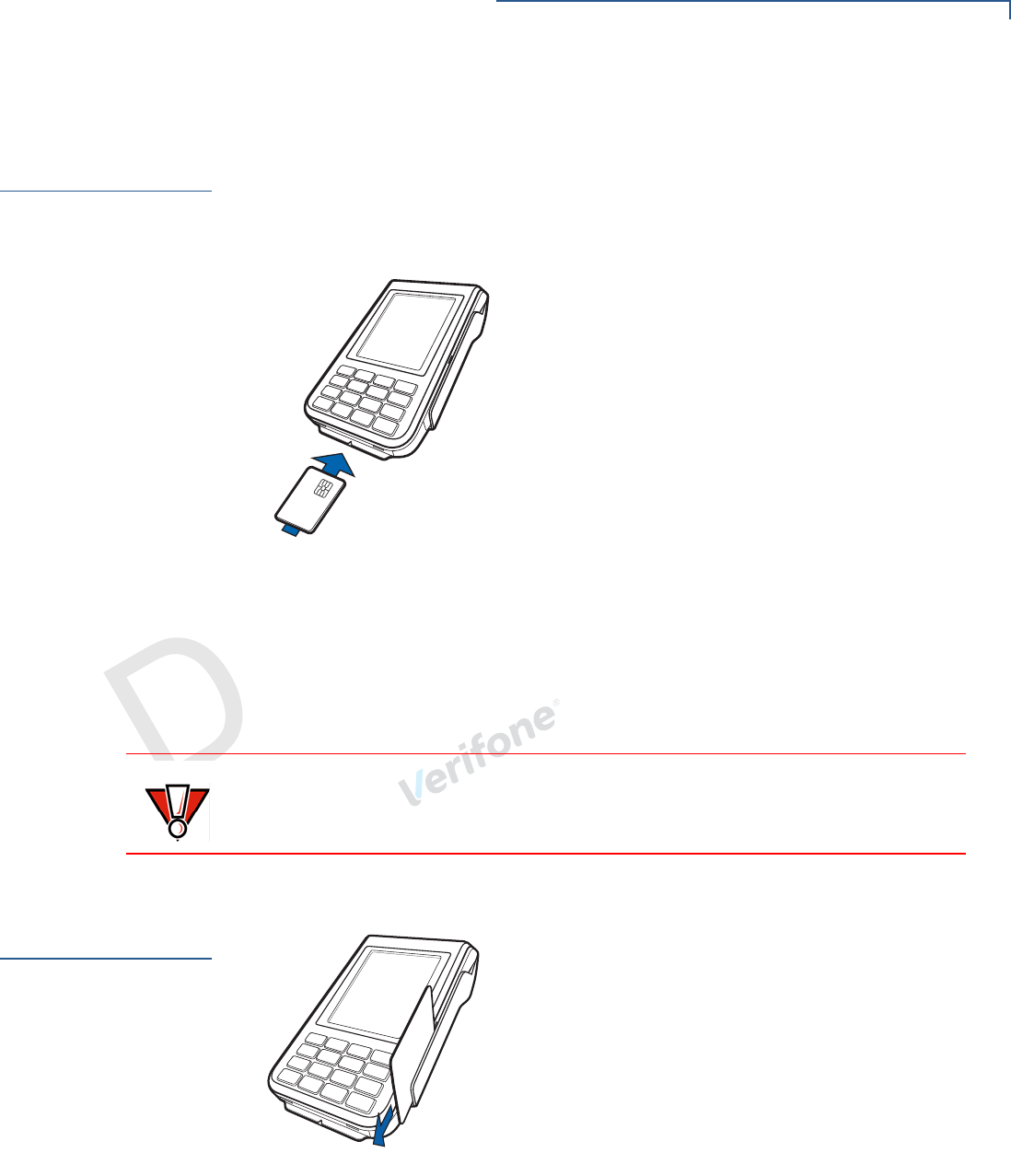
S
ETUP
Conducting Smart Card Transactions
C680 I
NSTALLATION
G
UIDE
23
RAFT
R
EVISION
B.6
Conducting
Smart Card
Transactions
The smart card transaction procedure may vary from one application to another.
Verify the procedure with your application provider before performing a smart card
transaction.
To Conduct a Smart
Card Transaction
1
Position a smart card with the contacts facing upward.
Figure 15 Smart Card Transaction
2
Insert the smart card into the smart card reader slot in a smooth, continuous
motion until it seats firmly.
3
Remove the card only when the application indicates the transaction is
complete.
Using the
Magnetic Card
Reader
The C680 terminal supports credit/debit card transactions.
Figure 16 Credit/Debit Card Transaction
To Conduct a Credit
or Debit Card
Transaction
1
Position a magnetic card with the stripe in the card reader and facing inward,
toward the keypad.
2
To ensure a proper read of the magnetic swipe card, the user should insert the
magnetic card from the top of the unit, as shown in the following illustration.
CAUTION
Do not remove the smart card in the card reader until the transaction is complete.
Premature card removal will invalidate the transaction.
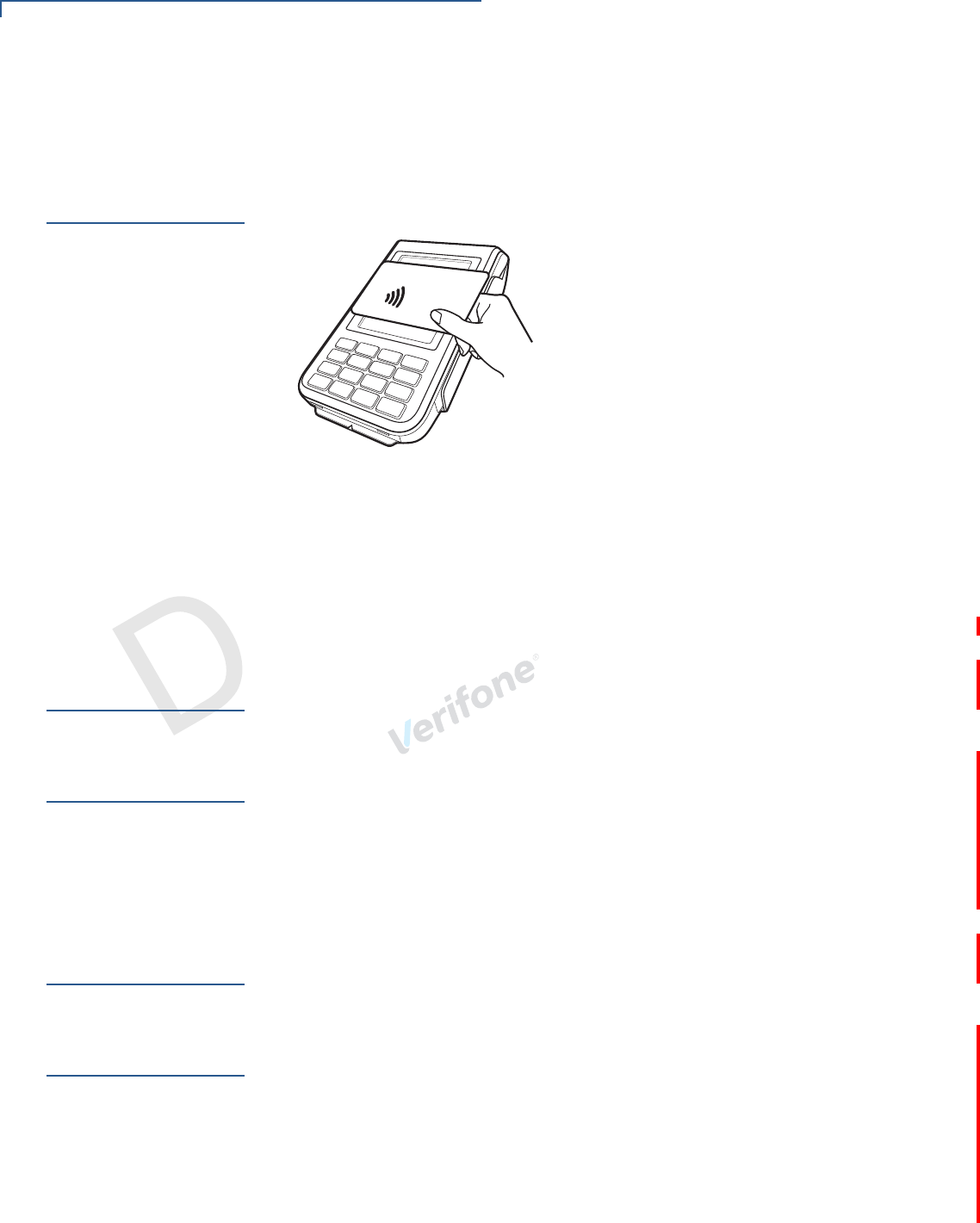
S
ETUP
Conducting a Contactless Transaction
24
C680 I
NSTALLATION
G
UIDE
RAFT
R
EVISION
B.6
3
Swipe the card through the magnetic card reader.
Conducting a
Contactless
Transaction
The C680 terminal supports contactless transactions through an integrated
contactless module. The terminal only becomes active for contactless smart card
transactions when initialized by an application.
Figure 17 Conducting Contactless Transactions
To Conduct a
Contactless
Transaction
1
Gently tap the card onto or hold the card (within 4 cm) against the surface of
the display.
2
An activated LED visual on the display accompanied by a short beeping sound
indicates a successful transaction.
Wireless
Transactions
To conduct a wireless transaction, ensure that the terminal is in optimal position
for transmitting. Follow the on-screen instructions provided on your application.
Bluetooth
Transactions
To conduct a Bluetooth transaction, ensure that the terminal is paired with another
Bluetooth device not more than 100 meters away. Follow the on-screen
instructions provided on your application.
To improve the range performance of the terminal, place the Bluetooth device in a
location that services all of the card payment areas in the premises. Ideally, place
within the line of sight of all areas of card acceptance.
3G and CDMA
Connectivity
To connect to existing 3G/CDMA operator-provided infrastructure, check that valid
SIM is inserted. See Installing the SIM/SAM/R-UIM/Micro-SD Cards.
Dial-up/Ethernet
Connectivity
There are specific markets that require the use of a C680 FF Dongle, which
provides dial-up/Ethernet connectivity. When these are properly configured,
connection to the network is made available.
1
Check that the Dongle is properly installed. See Installing the Dongle for more
information.
2
Ensure that RJ11 cable is plugged to the telephone port on the Dongle and the
other end is plugged to the telephone jack on the wall.
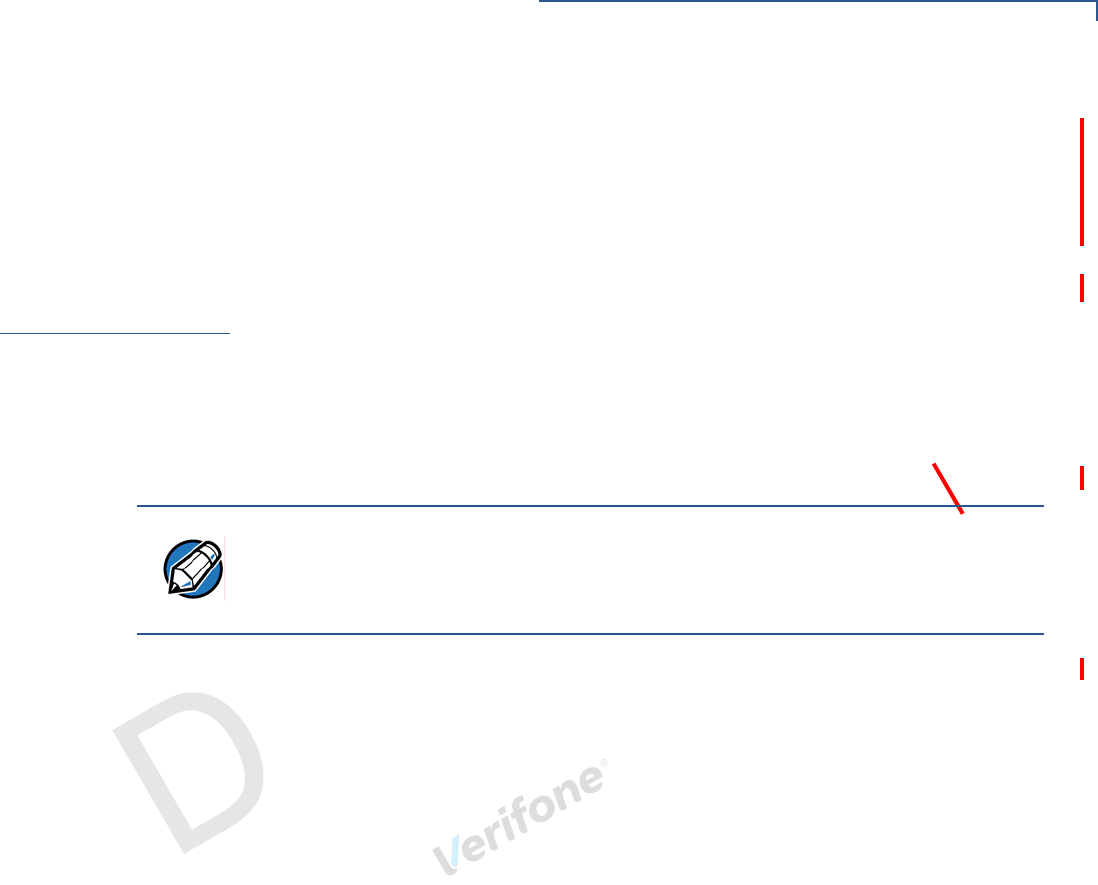
S
ETUP
Periodic Inspection
C680 I
NSTALLATION
G
UIDE
25
RAFT
R
EVISION
B.6
3
Ensure that RJ45 cable is plugged to the LAN port on the Dongle and the
other end is plugged to the network port on the wall.
4
Ensure that connections are properly created and configured before
connecting.
Periodic
Inspection
Periodically inspect the terminal for possible tampering. Signs of tampering
include:
•
Wires protruding out of the device.
•
Foreign objects inserted into the smart card or mag stripe slot.
•
Signs of damage to the tamper-evident labels.
•
Warning message on the device display.
NOTE
If any device is found in tamper state, please remove it from service immediately.
Keep it available for potential forensics investigation and notify your company
security officer and your local Verifone representative or service provider. For
contacting Verifone, refer to Verifone Service and Support.

S
ETUP
Periodic Inspection
26
C680 I
NSTALLATION
G
UIDE
RAFT
R
EVISION
B.6
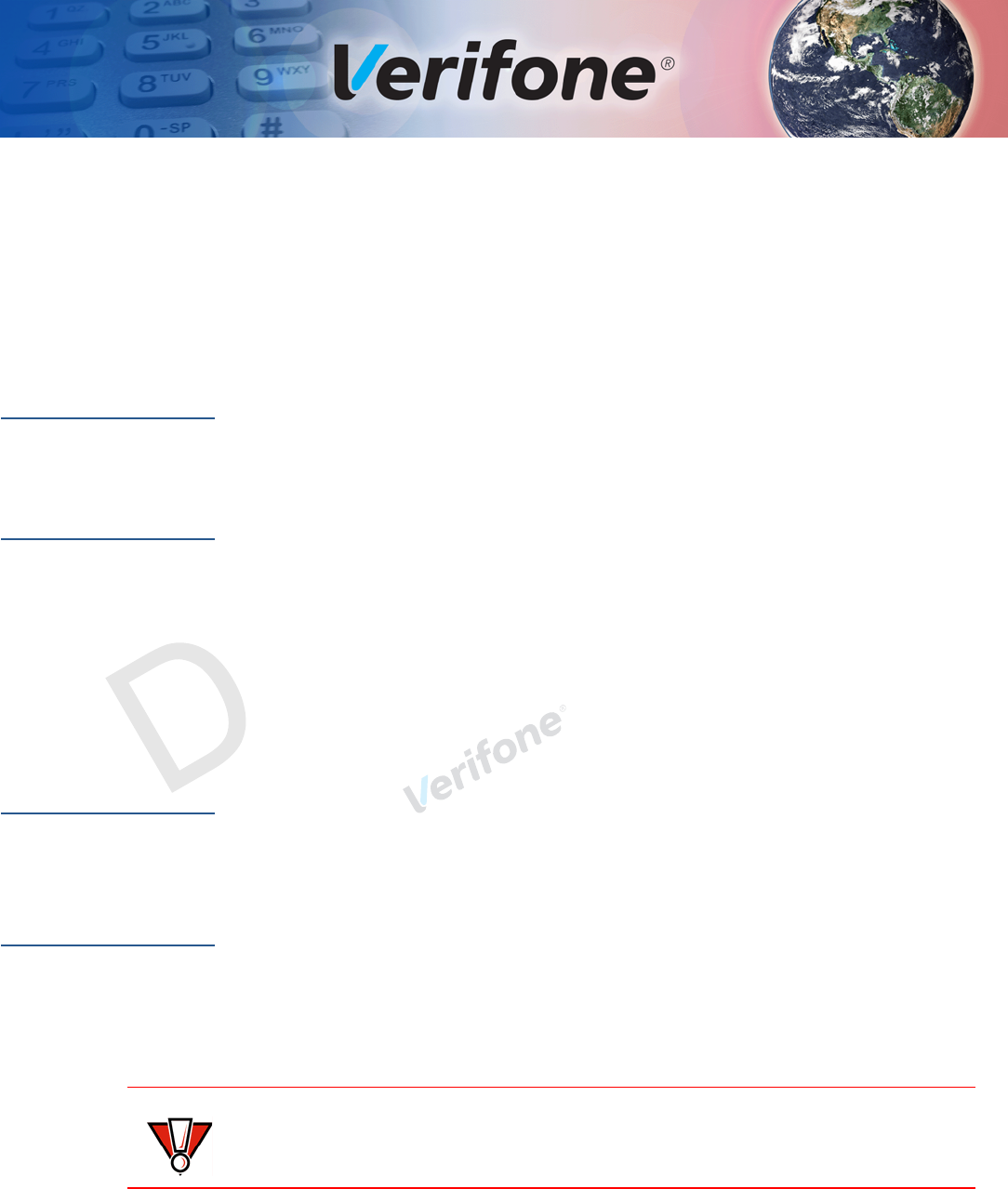
C680 I
NSTALLATION
G
UIDE
27
RAFT
R
EVISION
B.6
C
HAPTER
3
Specifications and Maintenance
This chapter discusses power requirements, dimensions, other specifications of
the terminal, and maintenance.
Power Pack
5 VDC 2.2 A (11W), compliant with ERP/EUP Stage 2.
a
Input rated: 100-240 VAC, 50/60 Hz
b
Output rated: 5 VDC 2.2 A
Temperature
Operating Environment
•
Temperature: -5 C to 40
C (23 F to 104
F)
•
Relative humidity: 5% to 95% RH non-condensing
Non-Operating Environment
•
temperature: -20 C to 50
C (-4 F to 122
F)
•
Relative humidity: 5% to 95% RH non-condensing
External
Dimensions
•
Length: 172.86 mm (6.8 in)
•
Width: 82.25 mm (3.2 in)
•
Depth: 59.3 mm (2.3 in)
•
Weight: 352 g
Maintenance
The C680 terminal and base have no user-serviceable parts.
Cleaning the
Terminal
To clean the terminal and base, use a clean cloth slightly dampened with water
and a drop or two of mild soap. For stubborn stains, use alcohol or an alcohol-
based cleaner.
CAUTION
Never use thinner, trichloroethylene, or ketone-based solvents. These may cause
deterioration of plastic or rubber parts. Do not spray cleaners or other solutions
directly onto the keypad or terminal display.
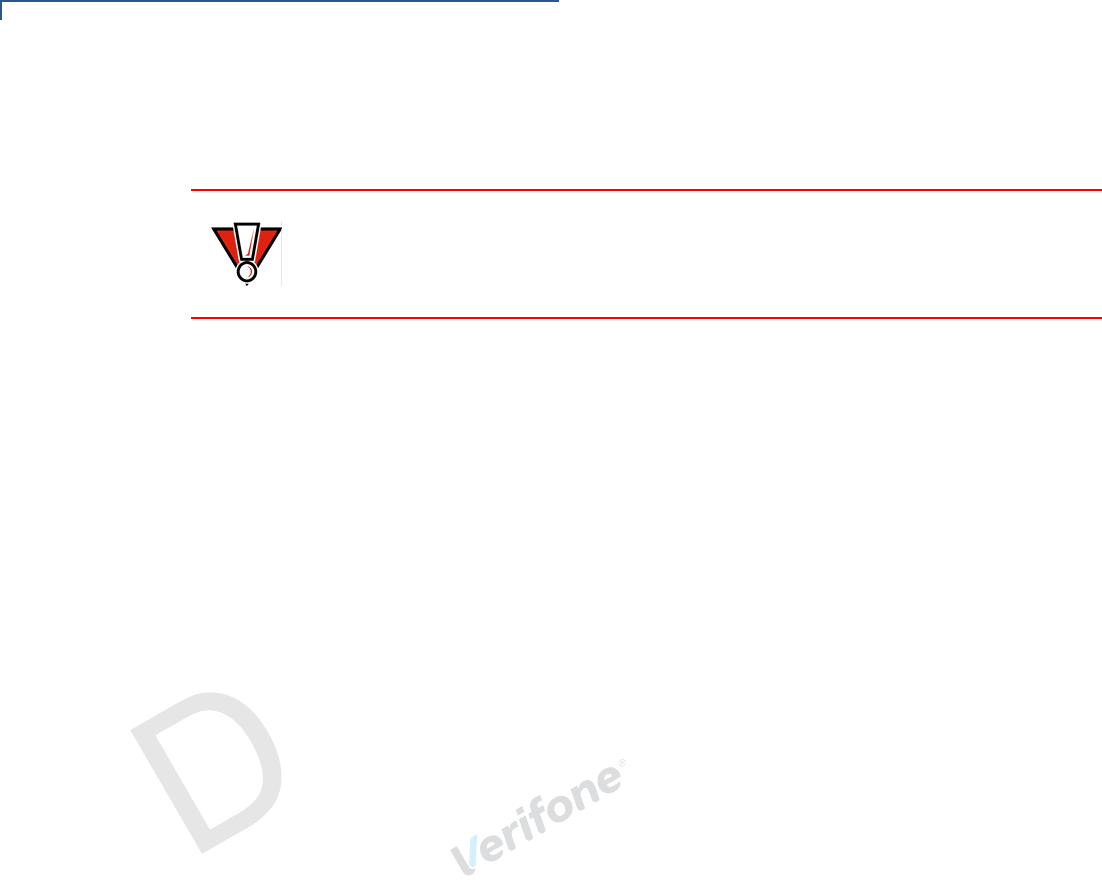
S
PECIFICATIONS
AND
M
AINTENANCE
Maintenance
28
C680 I
NSTALLATION
G
UIDE
RAFT
R
EVISION
B.6
Terminal Contacts
Gently swab the contacts with alcohol or contact cleaner to remove the dirt. It is
important that the exposed contacts of the battery stay clean and unbent.
Smart Card Reader
Do not attempt to clean the smart card reader. Doing so may void any warranty.
For smart card reader service, contact your Verifone distributor or service
provider.
CAUTION
Avoid touching the contacts of the battery and the recessed area on the terminal.
Finger oils tarnish contacts, causing bad connections. When operating on battery
power and experiencing a high occurrence of bad or incomplete data transfers,
clean the contacts.
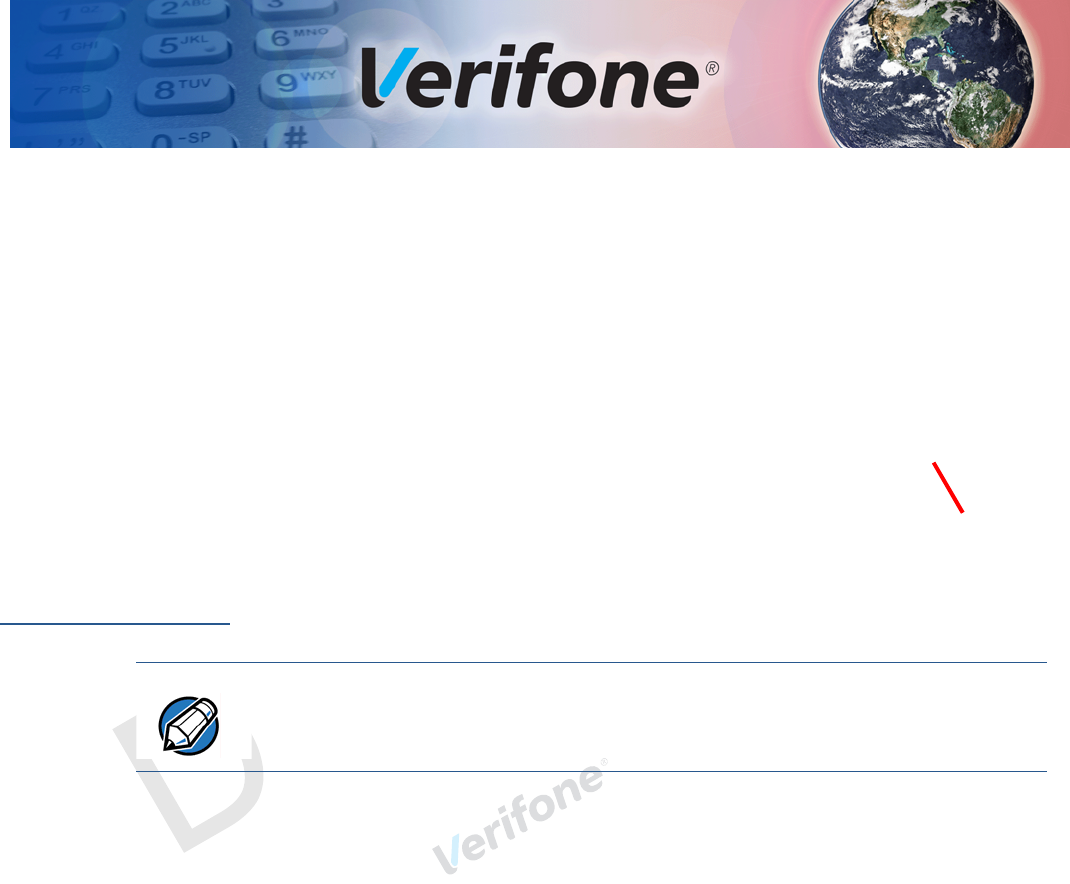
C680 I
NSTALLATION
G
UIDE
29
RAFT
R
EVISION
B.6
C
HAPTER
4
Verifone Service and Support
For terminal problems, contact your local Verifone representative or service
provider. For product service and repair information:
•
USA – Verifone Service and Support Group, 1-800-Verifone (837-4366),
Monday - Friday, 8 A.M. - 8 P.M., Eastern time
•
International – Contact your Verifone representative
Returning a
Terminal for
Service
Before returning a terminal or base to Verifone, you must obtain an MRA number.
The following procedure describes how to return one or more terminals or bases
for repair or replacement (U.S. customers only).
To Return a Terminal
for Service
1
Get the following information from the printed labels on the bottom of each
C680 terminal or base to be returned:
•
Product ID, including the model and part number. For example, “C680”
and “MXXX-XXX-XX-XXX-2.”
•
Serial number (S/N nnn-nnn-nnn)
2
Obtain the MRA number(s) by completing one of the following:
a
Call Verifone toll-free within the United States at 1-800-Verifone and follow
the automated menu options.
•
Select the MRA option from the automated message. The MRA
department is open Monday to Friday, 8 A.M.–8 P.M., Eastern Time.
•
Give the MRA representative the information you gathered in Step 1.
If the list of serial numbers is long, you can fax the list, along with the
information gathered in Step 1, to the MRA department at 727-953-
4172 (U.S.).
b
Address a fax to “Verifone MRA Dept.” with the model and part number(s)
•
Include a telephone number where you can be reached and your fax
number.
c
Complete the Inquiry Contact Form at http://www.verifone.com/aboutus/
contact/contact_form.cfm.
NOTE
Customers outside the United States are advised to contact their local Verifone
representative for assistance regarding service, return, or replacement of
terminals or batteries.
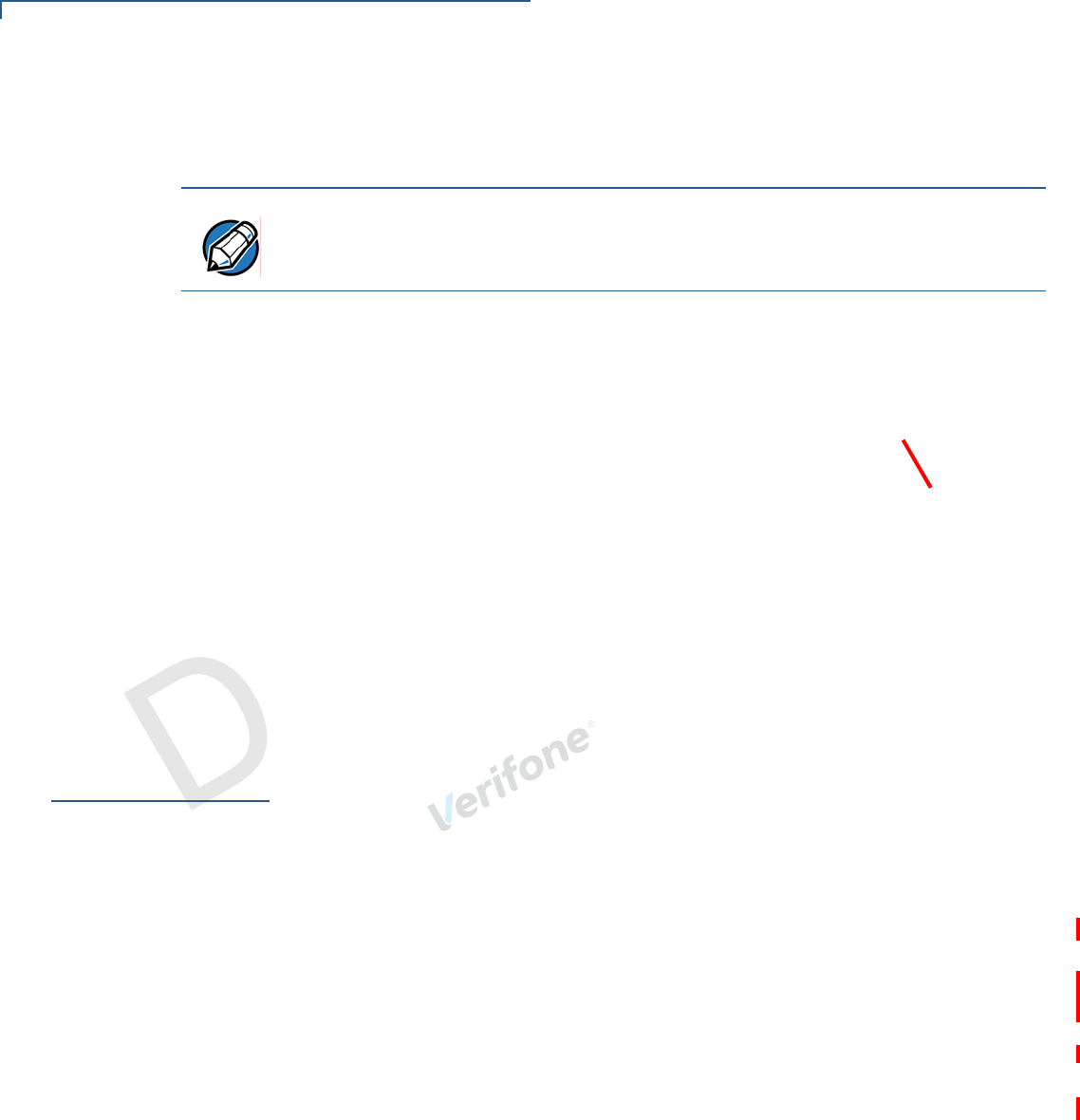
V
ERIFONE
S
ERVICE
AND
S
UPPORT
Accessories and Documentation
30
C680 I
NSTALLATION
G
UIDE
RAFT
R
EVISION
B.6
•
Address the Subject box with to “Verifone MRA Dept.”
•
Reference the model and part number in the Note box.
3
Describe the problem(s).
4
Provide the shipping address where the repaired or replacement unit must be
returned.
5
Keep a record of the following items:
•
Assigned MRA number(s).
•
Verifone serial number assigned to the terminal or base you are returning
for service or repair (terminal serial numbers are located on the bottom of
the unit.
•
Shipping documentation, such as air bill numbers used to trace the
shipment.
•
Model(s) returned (model numbers are located on the Verifone label on the
bottom of the terminal).
Accessories and
Documentation
Verifone produces the following accessories and documentation for the
terminal. When ordering, please refer to the part number in the left column.
•
Verifone online store at
www.store.verifone.com
•
USA – Verifone Customer Development Center, 800-Verifone (837-4366),
Monday - Friday, 7 A.M. - 8 P.M., Eastern time
•
International – Contact your Verifone representative
Dongle
The Dongle or the Y cable solution provides dial-up/Ethernet connectivity. It
suports a Host port, a serial port, an Ethernet port, and a dial-up modem port.
Power Pack
Contact your local Verifone distributor to determine which power pack fits your
needs.
Printer Paper
Verifone Cleaning
Kit
NOTE
One MRA number must be issued for each terminal you return to Verifone, even if
you are returning several of the same model.
VPN XXXXX-XXX-XX-X C680 Dongle
VPN PWR265-001-01-A DC Power Pack (Universal)
VPN PPR268-001-01-A 40 mm (1.57 in) diameter, 57 mm (2.24 in) wide
VPN 02746-01 Cleaning Kit
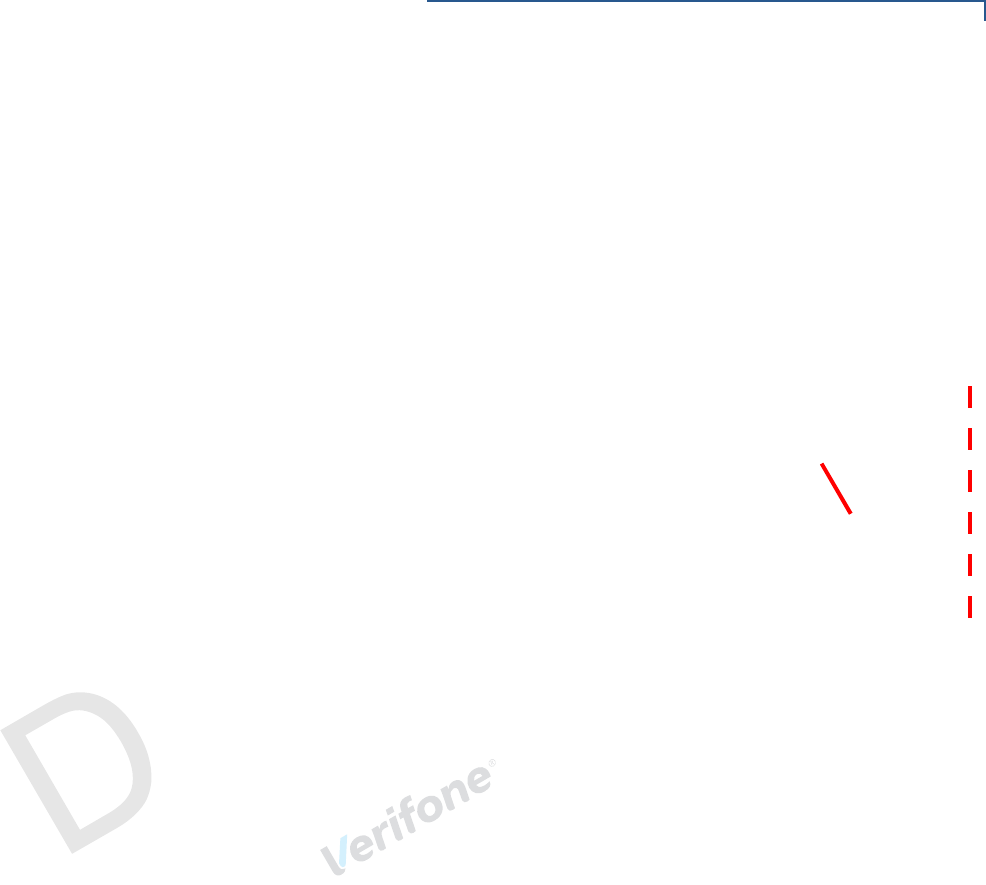
V
ERIFONE
S
ERVICE
AND
S
UPPORT
Accessories and Documentation
C680 I
NSTALLATION
G
UIDE
31
RAFT
R
EVISION
B.6
Micro-USB Cable
Documentation
VPN SUB265-001-01-A Micro-USB service dongle
C680
Certifications and Regulations Sheet DOC268-061-EN
C680
Quick Installation Guide DOC268-062-EN
C680
Reference Guide DOC268-064-EN
C680 3G
Certifications and Regulations Sheet DOC268-065-EN
C680 WiFi BT
Certifications and Regulations Sheet DOC268-067-EN
C680 WiFi BT
Quick Installation Guide DOC268-068-EN
C680 CDMA
Certifications and Regulations Sheet DOC268-069-EN
C680 FF Dongle
Certifications and Regulations Sheet DOC268-070-EN
C680 FF Dongle
Quick Installation Guide DOC268-071-EN
Verix eVo Volume I: Operating System Programming Manual DOC00301
Verix eVo Volume II: Operating System and Communications
Programmers Manual
DOC00302

V
ERIFONE
S
ERVICE
AND
S
UPPORT
Accessories and Documentation
32
C680 I
NSTALLATION
G
UIDE
RAFT
R
EVISION
B.6
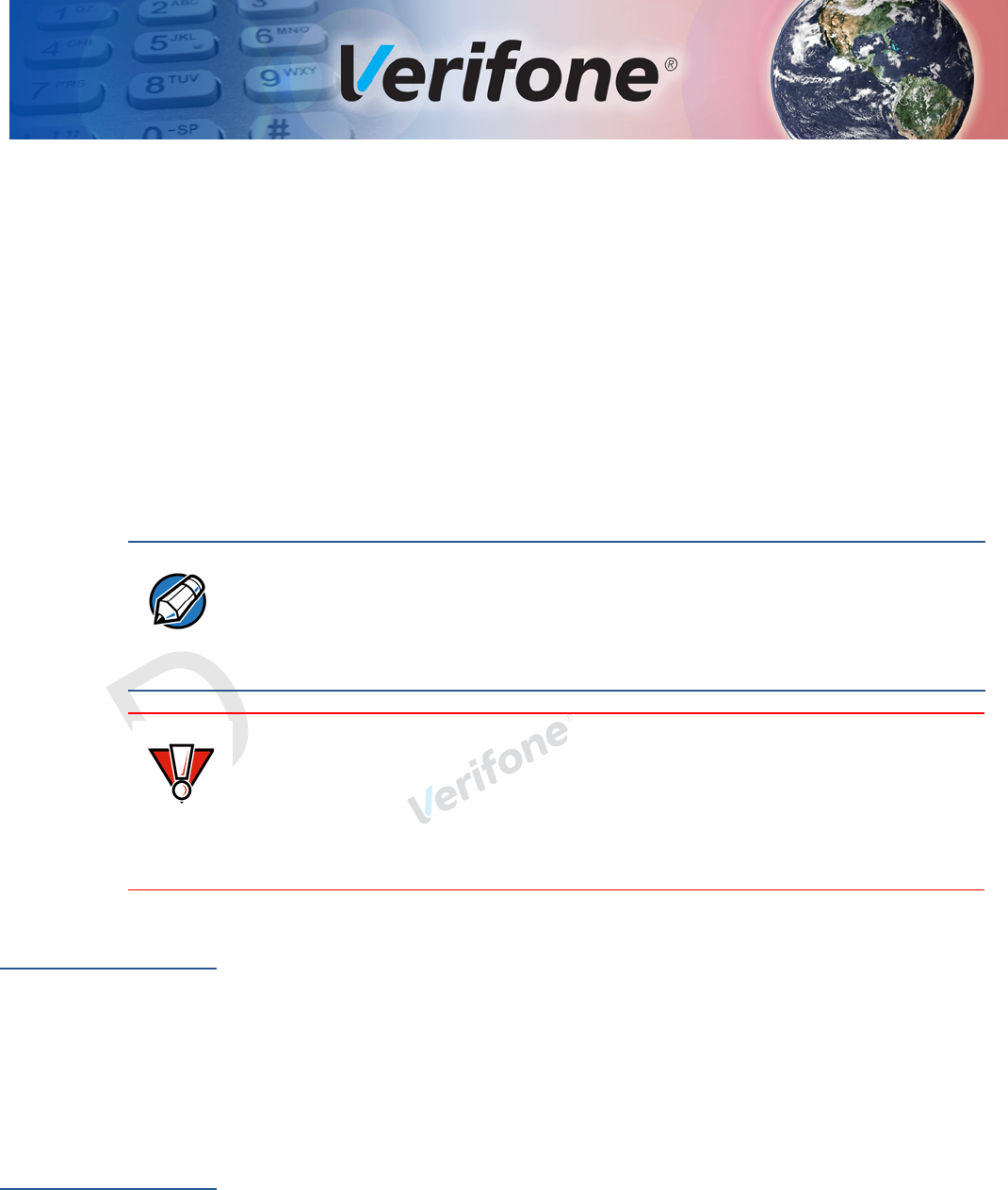
C680 I
NSTALLATION
G
UIDE
33
RAFT
R
EVISION
B.6
C
HAPTER
5
Troubleshooting
Guidelines
The troubleshooting guidelines provided in the following section are included to
help you install and successfully configure the device. Typical examples of
malfunction you may encounter while operating the device and steps you can take
to resolve them are listed in this chapter.
If the problem persists even after performing the outlined guidelines or if the
problem is not described below, contact your local Verifone representative for
assistance.
Terminal Does
Not Start
If the terminal does not start:
•
Ensure that the battery charge state is not below the critically low level.
•
Recharge or replace the battery.
•
Ensure that you pressed the green ENTER/ON key for approximately 4
seconds, until the unit lights up.
Does Not Show
Correct/
Readable Info
If the terminal does not show the correct/readable information:
•
Recharge or replace the battery.
•
Connect the terminal into a known-good power supply (if you have one) to see
if this clears the problem.
•
If the problem persists, contact your local Verifone representative for
assistance.
NOTE
The device comes equipped with tamper-evident labels. It does not come with
user serviceable parts. Do not, under any circumstance, attempt to disassemble
the device. Perform only the adjustments or repairs specified in this guide. For all
other services, contact your local Verifone service provider. Service conducted by
parties other than authorized Verifone representatives may void any warranty.
CAUTION
Use only a Verifone-supplied power pack. Using an incorrectly-rated power
supply may damage the terminal or cause it not to work as specified. Before
troubleshooting, ensure that the power supply being used to power the terminal
matches the requirements specified on the bottom of the terminal. (See
Specifications and Maintenance, for detailed power supply specifications.) Obtain
the appropriately rated power supply before continuing with troubleshooting.

T
ROUBLESHOOTING
G
UIDELINES
Battery Does Not Charge
34
C680 I
NSTALLATION
G
UIDE
RAFT
R
EVISION
B.6
Battery Does Not
Charge
The terminal’s battery must initially receive a full charge to ensure proper
operation.
•
Allow the terminal to remain connected to the power pack for 6 hours to
ensure the battery receives a full charge.
•
Li-ion batteries are not affected by shallow charging. Furthermore, when the
terminal has no external power source or battery the coin cell battery provides
power to the security circuit.
•
Uninstalling the battery and unplugging the terminal power pack reduce the life
of the coin cell battery, which does not recharge and must be replaced if
drained.
•
Conserve battery power by turning the terminal off when not in use. Keep the
Li-ion battery inserted in the terminal and power up the terminal periodically to
check the battery charge. Do not let the battery charge fall below 10% for
extended periods of time as this may permanently diminish the battery
capacity. Recharge the battery by attaching USB end of the power pack to the
terminal and plugging the other end of the power pack into a wall outlet.
•
The terminal automatically shuts off when the battery reaches the critically low
charge state. If this occurs, the battery must recharge a minimum of 1/2 hour
before it can power the terminal. It may take several recharge attempts to
reset the safety circuit when charging a battery that has been discharged
below this critical state.
Blank Display
When the terminal display screen does not show the correct or clearly readable
information:
•
The battery pack may not be connected properly. Remove and reinstall the
battery pack.
•
Check terminal power connection.
•
Remove and reapply power to the terminal.
•
If the problem persists, contact your local Verifone service provider.
Printer Does Not
Print
If the printer does not work properly:
•
Make sure the battery is properly installed in the terminal. The printer will not
print if there is no battery in the terminal.
•
Check battery status or terminal power connection. The printer will not print if
there is an insufficient charge remaining in the battery to complete the print
operation.
•
Check if the printer is out of paper (slow red blinking light) and that the roll is
properly installed. Open the paper roll cover and install a new roll of printer
paper or ensure that the roll is feeding correctly. A solid red indicator light
indicates a printer error.
•
Verify that the printer door is properly latched.

T
ROUBLESHOOTING
G
UIDELINES
Printer Paper Jam
C680 I
NSTALLATION
G
UIDE
35
RAFT
R
EVISION
B.6
•
If the problem persists, contact your Verifone distributor or service provider.
Printer Paper
Jam
If paper jams inside the printer:
•
Press the button at the bottom of the terminal to unlatch the paper roll cover,
then open the cover.
•
Remove the damaged paper from the paper roll and clear the feed
mechanism.
•
Install a roll of printer paper, as described in Installing the Paper Roll.
•
If the problem persists, it may be due to poor paper quality. Install a new roll of
higher-quality paper.
Keypad Does
Not Respond
If the keypad does not respond properly:
•
Check the terminal display. If it displays the wrong character or nothing at all
when you press a key, follow the steps outlined in Transactions Fail to
Process.
•
If pressing a function key does not perform the expected action, refer to the
user documentation for that application to ensure you are entering data
correctly.
•
If the problem persists, contact your local Verifone representative.
Transactions
Fail to Process
There are several reasons why the terminal may not be processing transactions.
Use the following steps to troubleshoot failures.
Check the Magnetic Card Reader
•
Perform a test transaction using one or more different magnetic stripe cards to
ensure the problem is not a defective card.
•
Ensure that you are swiping cards properly. With the C680 card reader, the
black magnetic stripe on the card should face down and inward, toward the
keypad and must be inserted from the top of the terminal.
•
Process a transaction manually, using the keypad instead of the card reader. If
the manual transaction works, the problem may be a defective card reader.
•
Contact your Verifone distributor or service provider.
•
If the manual transaction does not work, proceed to Check the Signal
Strength.
WARNING
Poor-quality paper may jam the printer. To order high-quality Verifone paper, refer
to Accessories and Documentation.

T
ROUBLESHOOTING
G
UIDELINES
Transactions Fail to Process
36
C680 I
NSTALLATION
G
UIDE
RAFT
R
EVISION
B.6
Check the Smart Card Reader
•
Perform a test transaction using several different smart cards to ensure the
problem is not a defective card.
•
Ensure that the card is inserted correctly and that the card is not removed
prematurely.
•
Contact your Verifone distributor or service provider.
•
If the manual transaction does not work, proceed to Check the Signal
Strength.
Check the Signal Strength
•
On-screen signal-strength indicator displays at least one bar to indicate
connectivity to radio network.
•
Ensure that the radio has been activated by your service provider.
.
